Explore Lean Thinking and Practice / Problem-Solving

Problem-Solving
Explore the process that’s foundational to assuring every individual becomes engaged by arming them with methods they can use to overcome obstacles and improve their work process.
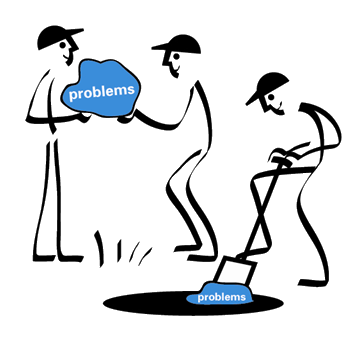
Overcoming obstacles to achieve or elevate a standard
In a lean management system, everyone is engaged in ongoing problem-solving that is guided by two characteristics:
- Everything described or claimed should be based on verifiable facts, not assumptions and interpretations.
- Problem-solving is never-ending; that is, it begins rather than ends when an improvement plan is implemented. The implementation process is a learning opportunity to discover how to make progress toward the target condition.
Lean thinkers & practitioners understand that the problem-solving process is impeded if you make the common mistake of mechanically reaching for a familiar or favorite problem-solving methodology or, worse, jump quickly to a solution.
Leaders and teams avoid this trap by recognizing that most business problems fall into four categories, each requiring different thought processes, improvement methods, and management cadences.
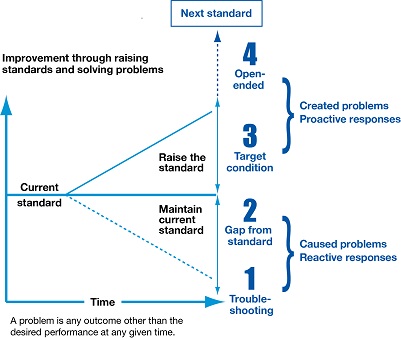
The Four Types of Problems
Type 1: Troubleshooting: reactive problem-solving that hinges upon rapidly returning abnormal conditions to known standards. It provides some immediate relief but does not address the root cause.
Type 2: Gap from Standard: structured problem-solving that focuses on defining the problem, setting goals, analyzing the root cause, and establishing countermeasures, checks, standards, and follow-up activities. The aim is to prevent the problem from recurring by eliminating its underlying causes.
Type 3: Target Condition: continuous improvement ( kaizen ) that goes beyond existing standards of performance. It may utilize existing methods in new, creative ways to deliver superior value or performance toward a new target state of improvement.
Type 4: Open-ended: innovative problem-solving based on creativity, synthesis, and recognition of opportunity. It establishes new norms that often entail unexpected products, processes, systems, or value for the customer well beyond current levels.
By helping everyone in the organization to understand the importance of taking ownership of seeing and solving all types of problems, lean thinking & practice:
- Engenders a sense of empowerment and autonomy in all workers, which in turn promotes engagement in and ownership of the work process
- Enables organizations to overcome obstacles at their source, so they do not become more significant problems upstream
Ultimately, building a problem-solving culture creates a competitive advantage that is difficult for competitors to match.
Relevant Posts

Problem Solving
Why the A3 Process Involves More than Filling in Boxes
Article by Tracey Richardson

Big Problems? Start Small
Article by Josh Howell

What’s your problem
Article, Video by John Shook
Recent Posts

Revolutionizing Logistics: DHL eCommerce’s Journey Applying Lean Thinking to Automation
Podcast by Matthew Savas

Transforming Corporate Culture: Bestbath’s Approach to Scaling Problem-Solving Capability

Empowering Employees and Driving Success at Kodiak: a Case Study of Lean Leader Program
Relevant Products
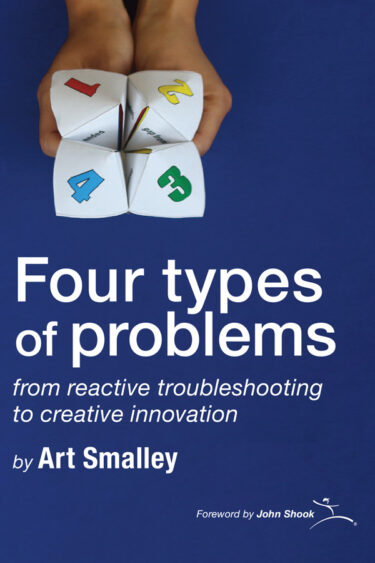
Four Types of Problems
by Art Smalley
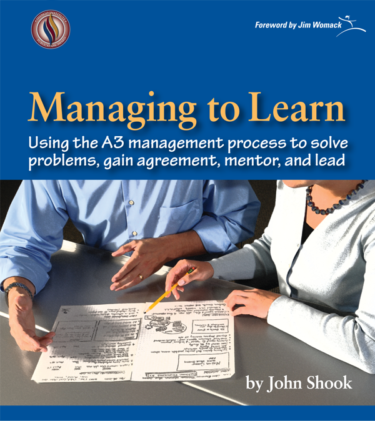
Managing to Learn: Using the A3 management process
by John Shook

Getting Home
by Liz McCartney and Zack Rosenburg
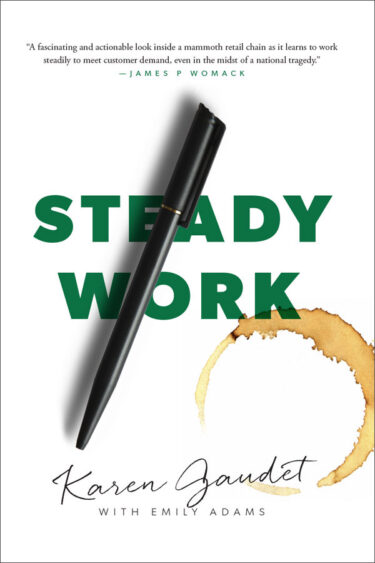
Steady Work
by Karen Gaudet
Relevant Events
January 24, 2025 | Coach-Led Online
Managing to Learn
March 03, 2025 | Atlanta, GA
Pre-Summit Workshops
April 15, 2025 | Morgantown, PA
Building a Lean Operating and Management System
Be the first to learn of new learning opportunities and the latest practical, actionable information. subscribe to an lei newsletter., join us on social, privacy overview.
- Application Profiles
- Hartford Global Consulting Services
- Case Studies
- Our History
- Global Team
- Manufacturing Capabilities
- Our Quality
- Who We Work With

- Special Bearings
- Cage Bearings
- Needle Bearings
- Drawn Cup Needle Bearings
- Cage Needle Bearings
- Thrust Bearings
- Plastic Bearings
- Ball & Roller Retainer Assemblies
- Ball Sleeves
- FAQ – Custom Bearing Assemblies
- Chrome Steel Balls
- Stainless Steel Balls
- Carbon Steel Balls
- Brass Balls
- Tungsten Carbide Balls
- Precision Glass Balls
- Plastic Balls
- Small Ball Pack Program
- Balls for Valves
- FAQ – Precision Balls
- Roller Ball Bearings
- Bearing Cages/Separators
- Bearing Races
- Bearing Sleeves / Wear Sleeves
- Needle Bearing Retainers
- Tripot / Tripod Ball – CV Joint
- FAQ – Bearing Parts
- Pins & Shafts
- Knurled Pins
- FAQ – Precision Pins
- Needle Rollers
- Precision Rollers
- Special End Rollers
- Tapered Rollers
- FAQ – Precision Rollers
- CNC Capability
- Agriculture
- Consumer Goods
- Electronics
- Recreational

- Industries & Applications
- Bearing Parts
- Custom Bearing Assemblies
- Precision Balls
- Precision Pins & Rollers
- Capabilities
Hartford Technologies Blog
35 lean manufacturing tools: the ultimate list, what is kaizen.
Kaizen is the Japanese word for “continual improvement.” The term refers to activities that improve every function of a business and is generally applied to manufacturing but can be used to make almost any business more efficient.
By definition, Kaizen includes the involvement of all employees, from upper management to assembly line workers and can be used to improve every process in a supply chain, from purchasing to logistics. The lean manufacturing tool was first used by the Japanese in World War Two and was a major influence of the book “The Toyota Way.”
What is the goal of Kaizen?
Kaizen seeks to improve standardized processes to eliminate waste, fix workflow issues, and solve business problems.
How is Kaizen implemented? The Kaizen method generally involves 5 primary steps:
- Identify the problem area that will be given focus.
- Utilize videotape to analyze the current method.
- Test and evaluate improvement tactics.
- Implement improvements.
- Analyze results and present them to upper management for feedback.
What is Kaizen most applicable to?
The Automotive Industry. The Toyota Production System made the tool famous. If problems occur within the production process, Toyota assembly line personnel and their supervisors are expected to stop the production process and begin a Kaizen.
2) One-Piece Flow

What is One-Piece Flow?
One-piece flow is the sequence of a product or service through a process that is one unit at a time. One-piece flow is the opposite of batch processing, where a large number of products are created at once and they are sent through the manufacturing process as a batch or group. In One-Piece Flow the focus is on the manufacturing of the product itself rather than the waiting, transportation, and storage of the product.
What are the advantages of One-Piece Flow?
The advantages are:
- Ability to detect defects earlier and more accurately.
- More flexibility for customization and meeting customer demands.
- Reduces costs by eliminating waste.
- Reduce the amount of work in progress to make each step more efficient.
- Easier to predict shipment times.
To increase efficiency, companies can choose to implement One-Piece Flow or simply reduce the number of products produced in a batch.
What is Jidoka?
Jidoka was invented in 1896 and was used to stop the shuttle of an automatic loom in a case where a thread broke. Not only did this reduce the number of defects when threading, it allowed operators to operate multiple looms at once instead of having to watch only one in case something went wrong. It is essentially automation with a human element.
What are the principles of Jidoka?
The principles can be broken down into four steps:
- Discover an abnormality or problem.
- Stop the operation process.
- Fix the problem at hand.
- Discover the root cause to prevent future issues.
The primary innovation Jidoka brought to lean manufacturing is the idea of examining a manufacturing issue in the middle of the process rather than at the end. Inspecting throughout the manufacturing process can play a key role in preventing defects and fixing problems before they cause significant damage.
4) Poka Yoke
Source: medium.com
What is Poka Yoke?
Poke Yoke was developed by Toyota and is very similar to Jidoka. The idea of Poka Yoke is to prevent mistakes from becoming defects. Mistakes, it argues, are inevitable, but defects that reach customers are preventable. The goal is to create a form of quality control that highlights defects automatically and eventually takes humans out of the equation.
Why use Poka Yoke?
The tool was invented because of human error. Humans who perform repetitive manufacturing tasks day in and day out can very easily miss common mistakes and defects. Automation was necessary to improve the manufacturing process.
A real-life example of Poka Yoke? An alarm that goes off automatically when you leave a car without turning off the headlights. Another example is a conveyor belt that rejects an underweight product. The goal is to prevent mistakes automatically, without human inspection.
5) Visual Management
What is visual management.
Visual Management is a communication technique that uses visual aids to convey messages quicker and more efficiently
What is the goal of Visual Management?
The objectives of Visual Management are:
- Clarify waste.
- Display problems in a simpler way.
- Indicate your efficiency goals.
- Increase effective communication.
An example of Visual Management? Stock controls, auditing boards, and shadow boards. Oftentimes, visual management can improve communication and help improve efficiency. Other times, visual aids can become confusing and too much to remember.
Where is Visual Management best applied? Work instructions can often be simplified and far easier to understand when visual aids are included. For example, if a work must build a piece of furniture from multiple parts, it will often be better understood in a visual format. It is particularly useful for tasks that are difficult to explain with words alone. Another example may be showing works a picture of a completed task.
What is Kanban?
Kanban is the Japanese word for “Signal Card.” In previous decades, manufacturing workers would fill out a signal card when a part was running low. The signal card would be sent to a team or employee whose job was to order more of that part. Today, this process is mostly computerized. The idea of Kanban is to buy more parts only when needed.
The goal of Kanban? The primary goal of Kanban is to reduce waste. If parts are only bought when needed, you are less likely to waste time, money, or space ordering unnecessary parts. However, if parts are bought automatically, without knowing if they are needed, it can cut into a company’s profits.
The strategy creates more efficient processes because the strategy is implemented based on consumer demand. If there is a lot of demand for a product only then should you order more. If there isn’t sufficient demand, companies can prevent unnecessary orders.
7) Demand Management
Source: fourquadrant.com
What is Demand Management?
Demand Management is a lean tool used to identify all demand coming from an external environment, manage it, and input it into a supply chain within a company.
The goal of Demand Management:
Demand Management has three primary goals:
- Improve forecast accuracy.
- Lessen investment in inventory.
- Create a more effective balance between supply and demand.
How is Demand Management implemented? The main element of implementing Demand Management is creating a more transparent supply chain. Companies must ensure transparency from all suppliers working with a company, from the largest to the smallest. By ensuring that every player in the supply chain is transparent, you can begin to create a more efficient supply chain.
Next, companies must determine, which inventory is unnecessary and can be reduced. Having too much inventory is expensive and difficult to maintain. Ultimately, this technique gets products out to consumers more efficiently.
8) Heijunka
What is heijunka.
Heijunka is the Japanese word for “leveling.” Heijunka is meant to level the type and quantity of production, while reducing batching. Ford Motor was once known for manufacturing cars in batches. Toyota used Heijunka to minimize batching and create a more efficient manufacturing process.
What is the goal of Heijunka? To reduce inventories, capital costs, manpower, and production time to a minimum.
When is Heijunka implemented? According to many lean experts, Heijunka is best implemented after a company has already implemented more basic lean principles?
What’s a good example of Heijunka? Say a hat manufacturer receives 500 orders for hats every week. 100 on Monday, 50 on Tuesday, 50 on Wednesday, and 300 on Thursday. Instead of manufacturing 500 hats at the beginning of the week or the exact amount needed each day, the company would produce exactly 100 hats per-day. By producing the same amount every day, the factory can optimize the manufacturing process for 100 hats and therefore create a more efficient process.
9) Just in Time
What is just in time.
As you could probably guess, Just in Time is a lean tool that calls for the production of what a customer wants, when they want it, in the quantity they want it, and where they want it. Instead of creating a large stock of a product that sits in warehouses, you only create as much of an item as a customer actually wants. This reduces unnecessary inventory and ensures that companies only spend on stock that will be paid for.
What is the history of Just in Time?
Just in Time was invented by Toyota during WWII. The tool was invented at a time when producing extra stock was simply too expensive and not possible. Companies could only afford to produce what a customer actually wanted.
The idea for Just in Time came from a visit to US supermarkets by Toyota managers. They noticed that shelves were only filled when a product ran out, not before that.
10) Takt Time
what is takt time.
What is the goal of Takt Time? The goal of Takt is to deliver the right product to the right customer at the right time, all with minimal waste. It ensures that products are manufactured in the most efficient way, while meeting consumer demand.
Another goal of Takt Time is to create a solid flow of operations within a supply chain. Measuring Takt Time will allow managers to determine capacity and synchronization issues within a supply chain and then find proper solutions.
Example of Takt Time? Here is an example:
Total Time: 8 Hrs X 60 Min = 480 Min
Breaks: 50 Min
Time Available : 430 Min
Customer Demand in 8 Hrs: 100 Pieces
Takt Time: 430 / 100 = 4.3 Min = 258 Sec
11) Bottleneck Analysis
What is a bottleneck, the goal of bottleneck analysis.
When should Bottleneck Analysis be implemented? When managers or operators suspect that the manufacturing process is taking too long. At this point, managers will try to determine exactly where the bottleneck is occurring.
What is Andon?
How is it used? In manufacturing, Andon lights are generally used in assembly lines. Different colored lights are used to signal different problems and actions required. Operators may turn on an Andon in order to signal that there is a problem in an assembly line. In an office setting, a red colored light (Andon) may signal that a fax machine or printer is broken.
In cars, warning lights on a car’s dashboard would be examples of Andons. Andons work best when they are highly visible and easy to understand. They must go hand in hand with an action. So, for example, an Andon warning light on a car that signals low gas, would indicate a clear action: fill up the tank with more gas.
Source: agileleanhouse.com
What is Gemba?
How is Gemba implemented?
Gemba is a step by step process:
- Engineers physically go to manufacturing floor to observe processes.
- Engineers collect data and understand the work being done
- Engineers ask questions.
- Engineers learn about problems and come up with solutions.
Gemba Walks refer staff taking the time to walk through the factory, examine what is going on, and determine if there are any issues. In the lean management philosophy, staff are expected to do Gemba Walks at least once a week.
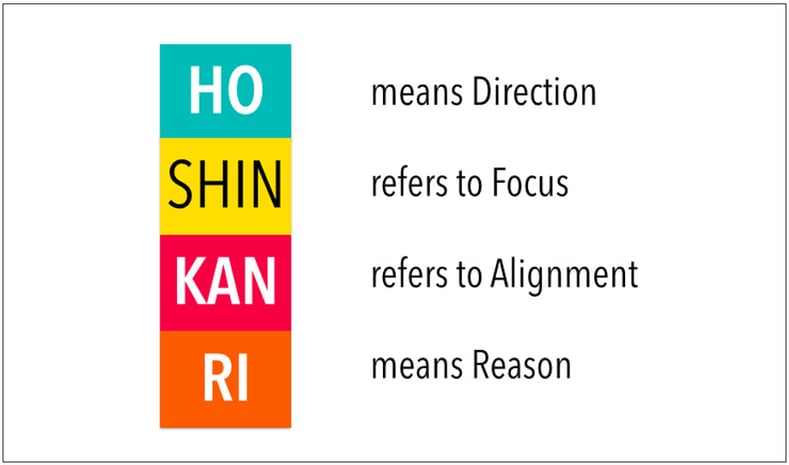
What is Hoshin Kanri?
What is the goal of Hoshin Kanri? The goal of Hoshin Kanri is to determine your strategic objectives and then align them with specific resources and action plans to meet those objectives.
What are the 7-steps of Hoshin Kanri?
The 7-steps of Hoshin Kanri:
- Determine an organizational vision. Figure out what your current mission and long-term vision is.
- Establish breakthrough objectives. Determine what significant improvements a business needs in the next three to five years.
- Come up with annual objectives to complete on a yearly basis.
- Determine metrics to measure objectives.
- Implement objectives.
- Review objectives monthly. Determine your progress each month to see where your business needs improvement.
- Review objectives yearly. Determine your progress each year to see where your business needs improvement.
15) Overall Equipment Effectiveness (OEE)
Source: wikihow.com
What is OEE?
OEE is a system used to measure manufacturing productivity. It measures the percentage of time that a manufacturer is truly productive. So, a 100% would mean that a manufacturer is productive 100% of the time. OEE includes measurement of quality, performance, and availability.
What is the goal of OEE?
By measuring productivity in terms of time, manufacturers can gain insight into how to improve overall manufacturing performance. The system helps to identify waste, track progress, and improve manufacturing equipment efficiency.
What do quality, performance, and availability really mean?
- Quality measures the number of defects. A 100% score indicates that there are zero defects.
- Performance measures slow cycles and stops. A 100% score indicates everything is running as quickly as possible.
- Availability takes into account any stops. A 100% score indicates that the process is always running during set production times.
16) Cellular Manufacturing

What is Cellular Manufacturing?
Cellular Manufacturing is the process of producing similar products in one cell. The product, in Cellular Manufacturing, moves through the production process in a single unit without interruptions. In Cellular Manufacturing, similar products can be produced on the same assembly line.
What are the benefits of Cellular Manufacturing?
The benefits of Cellular Manufacturing include:
- Group similar products together to reduce the time of changeover.
- Effectively utilize space during the entire production process.
- Increase flexibility and transparency.
- Reduce lead time.
- Increase overall productivity.
- Enhance teamwork and communication between employees and departments.
Example of Cellular Manufacturing? A metallic case arrives in a factory and needs to be assembled. Assembly requires a variety of different steps. The goal of Cellular Manufacturing is for all the steps to occur in one area, in a single cell. This reduces the time it takes to transport the parts during the production process.
17) Continuous Improvement
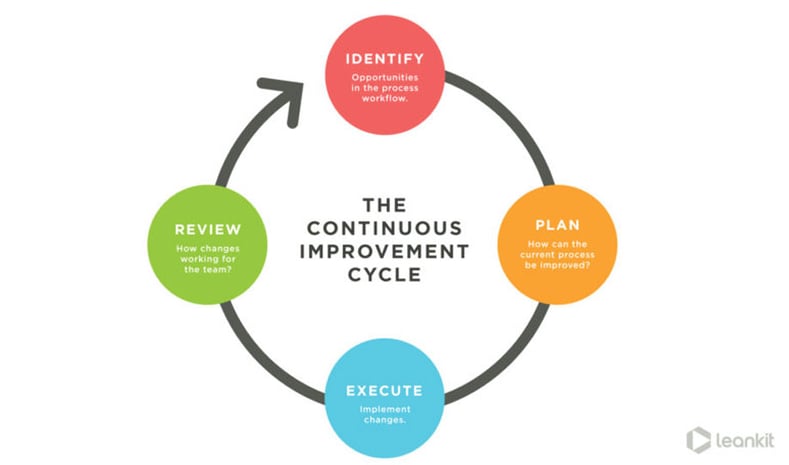
Source: mktgcdn.leankit.com
What is Continuous Improvement?
Continuous Improvement is a methodology within lean manufacturing that advocates following formal practices to improve efficiency over time.
What are the benefits of Continuous Improvement?
The benefits of Continuous Improvement include:
- Efficient workflows.
- Saves time.
- Reduces cost.
- Reduces resources needed.
How is Continuous Improvement implemented? Continuous Improvement is implemented in four steps:
- Figure out what needs improvement and create a plan.
- After the plan is complete, implement the plan.
- Collect data to figure out if the plan worked and if it needs improvement.
- Once the plan has worked on a small scale, implement it on a wider scale.
18) Total Productive Maintenance
Source: nevilleclarke.com
What is Total Productive Maintenance?
Total Productive Maintenance is a lean tool used to prevent machine downtime within the production process. The goal is to limit downtime as much as possible to increase production efficiency
How is Total Productive Maintenance implemented?
Total Productive Maintenance includes three main components:
- Preventative maintenance. These included planned maintenance activities that are regularly scheduled. The crew will perform these periodically throughout the year. It includes checking all equipment for problems and fixing any issues. The goal is to prevent problems before they occur.
- Corrective maintenance. Managers and crew check equipment and determine whether problematic equipment needs to be replaced altogether. Oftentimes, it is more cost-effective to replace equipment before they break. Replacing equipment can often increase efficiency and profits.
- Maintenance prevention. This procedure makes sure that all equipment bought is exactly what’s needed. Buying faulty or incorrect equipment can result in increased maintenance responsibilities and and production inefficiencies down the line.
19) Total Quality Management
Source: smartsheet.com
What is Total Quality Management?
Total Quality Management is an organizational effort to improve the quality of a manufactured product. The goal is to increase the quality of every single step in an organizational workflow.
What are the origins of Total Quality Management? Total Quality Management was first implemented in 1923 by Walter Shewhard while he was working at Bell Telephone Laboratories. It was later used by Japanese Manufacturers and implemented on a mass scale in the 1980s.
What are the principles of Total Quality Management?
There are a few main principles of Total Quality Management:
- Focus on the customer. The goal of Total Quality Management is to improve the product offered to customers and therefore keep customers satisfied.
- Strategy. Total Quality Management requires a strategic approach that utilizes a set methodology.
- Continuous improvement. Ensuring quality takes time and it must be analyzed and improved annually.
20) Root Cause Analysis
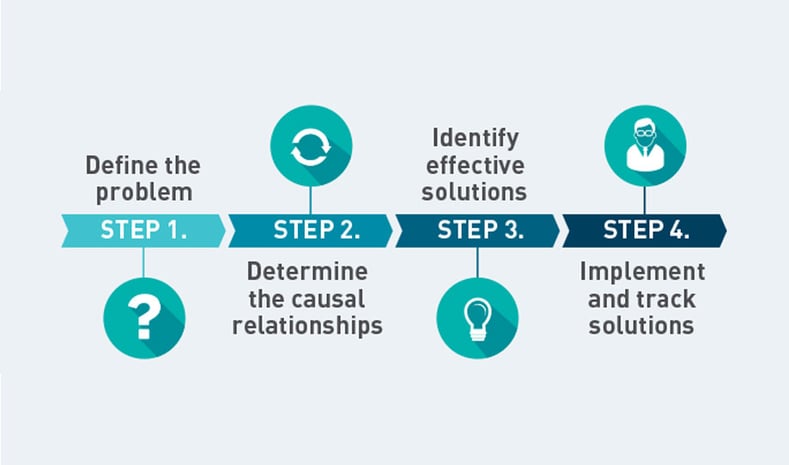
Source: apollorootcause.com
What is Root Cause Analysis?
Root Cause Analysis is a lean problem-solving method that aims to get to the root of a problem. The philosophy of RCA is predicated on the idea that it’s best to treat the root cause of a problem, not the obvious symptoms. By treating the root cause, manufacturers can eliminate larger problems down the road. Still, Root Cause Analysis will generally not fix problems in one try and is generally an iterative process.
What are the main principles of Root Cause Analysis?
The main principles of Root Cause Analysis include:
- Root Cause Analysis aims to identify the root cause of a problem to prevent it from ever occurring again. It’s a long-term solution.
- Root Cause Analysis must be an investigative and systematic process to work effectively.
- Every problem only has one root cause.
21) Value Stream Mapping
What is value stream mapping.
Value Stream Mapping is a lean tool that uses a flow diagram to depict every step of a process.
What is Value Stream Mapping used for?
Value Stream Mapping serves three main purposes:
- Identify waste.
- Reduce manufacturing time.
- Make the entire manufacturing process more efficient.
What is Value Stream Mapping applicable to? Value Stream Mapping can be applicable in almost any industry, but it is primarily used for logistics, supply chain, product development, and administrative processes.
What data should be collected to create a Value Stream Mapping? Some data points to collect for Value Stream Mapping include:
- Number of operators.
- Number of shifts worked.
- Batch size.
- The time it takes to make one product.
- The time it takes to switch from one product to the next.
- How much time factory can run.
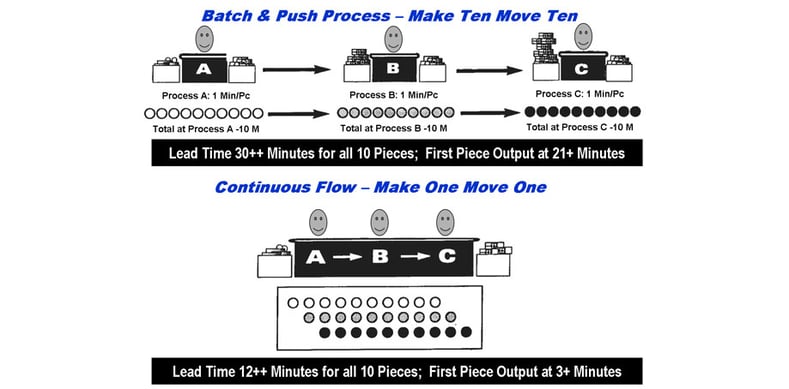
Source: agilelea.com
What is Continuous Flow?
Continuous Flow is the opposite of batch production and is closely associated with Kanban and Just-in-Time. The goal of Continuous Flow is to use ongoing examination and improvement to integrate all elements of production. By aiming for a Continuous Flow production process, waste and other problems come to the surface and can then be solved. Ultimately, many lean principles and tools center around creating a Continuous Flow production process.
The Continuous Flow process generally involves a factory running 24/7 without interruption and with little waste. Areas like oil refining, metal smelting, and natural gas processing are ideal for the Continuous Flow process.
What are the benefits of Continuous Flow?
The benefits of Continuous Flow include:
- Continuity.
- Waste-less process.
- No time wasted.
23) Lean Audit
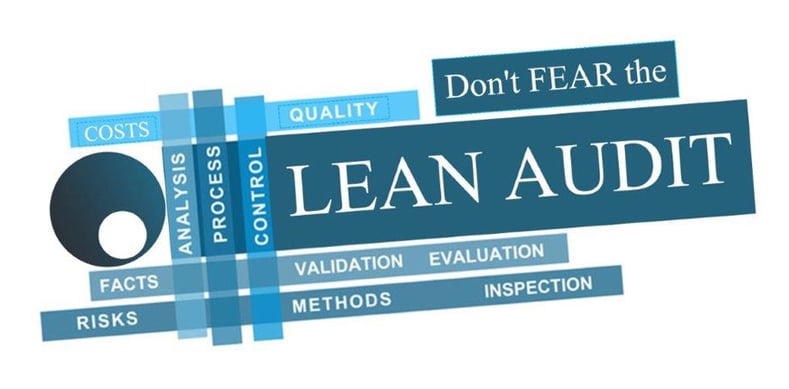
Source: exegens.com
What is a Lean Audit?
A Lean Audit is a tool used to determine how well lean manufacturing principles are working in a factory or company.
How is a Lean Audit implemented?
A Lean Audit generally has 5 steps:
- Identify the objective of your audit. This involves determining what lean processes you are already using and coming up with metrics to decide how well they are working. The goal of a lean audit should be to improve overall efficiency, reduce waste, and lower production costs.
- Determine who will conduct the audit. Lean Audits are best performed by a third party team in order to ensure objectivity, however, senior management may choose to conduct the audit internally.
- Create a point system to measure progress.
- Use a system to perform the audit. Ideally, a Lean Audit will be performed using lean principles.
- Follow up with the audit to ensure that all problems get fixed. Ideally, Lean Audits should be performed on a small-scale monthly and on a large-scale yearly.
24) Quick Changeover
What is quick changeover.
Changeover is the amount of time it takes to change a piece of equipment between the production of one item to the next. In Lean, the goal is to ensure a Quick Changeover.
An example of Quick Changeover?
A pit crew at a car race is a great example of a Quick Changeover. The quicker a crew can a changeover, the better chance a racer has of winning. A slow changeover will often result in losing a race.
What are the benefits of Quick Changeover?
The main benefits of Quick Changeover are:
- Reduce the amount of defects.
- Reduce inventory costs.
- More production flexibility.
- Better chance of on-time delivery.
25) Right First Time
What is right first time.
Right First Time is a lean philosophy that stresses getting processes right the first time, every time. The concept involves planning and a deep understanding of manufacturing processes.
How is Right First Time implemented?
Right First Time has 3 primary steps:
- Track performance. The first step of Right First Time is figuring out how often you’re getting your manufacturing processes right the first time. Search for areas in the manufacturing process where things do not go smoothly the first time around. By identifying the problems, you can figure out where your manufacturing processes need work.
- Improve performance with a systematic process. Often, the biggest problem manufacturers have is human error. The more systematic a process becomes, the more likely you can get things right the first time.
- Identify areas of waste and use the Right First Time tool to cut them out. Main areas to focus on include inventory, overproduction, defects, and transportation.
26) 7 Wastes Source: blog.triaster.co.uk
What is 7 wastes.
In lean manufacturing, 7 Wastes refers to seven typical places manufacturers have waste. Using the 7 Wastes tool, manufacturers can determine where they have waste and can improve their processes in each area. The method was invented by Toyota and is an integral part of the Toyota production system.
What are the 7 Wastes?
The 7 Wastes are as follows:
- Overproduction. Overproduction refers to producing a product before it is needed. In the Toyota production system, products are produced only when there is customer demand.
- Waiting. Waiting refers to the time between one operation and the next.
- Transporting. Transportation adds no value to a product and only too much transporting only increases the risk of defects.
- Inappropriate processing. This refers to using overly expensive equipment to accomplish tasks that can be processed by simpler and most cost-effective equipment.
- Unnecessary inventory. The goal is to reduce inventory to what’s needed.
- Excessive motion. Human motion should be reduced in the manufacturing process.
- Defects. Reducing defects is crucial for reducing costs.
27) Six Big Losses
Source : e-qms.co.uk
What are the Six Big Losses?
Six Big Losses refers to the six most common reasons for ineffective production. TPM and OEE are generally used to eliminate the Six Big Losses.
- Breakdowns. Breakdowns refer to machine failure and the need for intensive maintenance.
- Setup/Adjustment. Setup/Adjustment refers to changeover and machine warm-up.
- Idling. Idling refers to jams, obstructions, and cleaning.
- Speed. Speed refers to operator efficiency and machine wear down.
- Defects in process and rework. Defects refer to product damages and the need for corrections.
- Start-up losses. Start-up losses refer to improper assembly and losses due to product defects.
28) SMART Goals
What are smart goals.
SMART Goal is a method to set goals productively. To effectively use lean manufacturing methods, management must set proper goals to strive for. Ideally, those goals should be clearly defined and communicated.
What does SMART stand for? For a goal to be achieved it should be:
- Specific. A goal should be concrete and based on facts and figures.
- Measurable. Results must be quantified with clear numbers.
- Attainable. Goals should be attainable and not too ambitious. Impossible goals hurt employee morale.
- Realistic. Similar to attainable, goals must be set realistically based on available resources and time.
- Time-based. Goals must be given a realistic due date based on available resources.
What are KPIs?
KPI is an acronym for Key Performance Metric and it refers to metrics used to assess and analyze manufacturing efficiency. KPIs are essentially metrics set by management to measure the success of lean manufacturing goals.
What are some common manufacturing KPIs?
Some common manufacturing KPIs include:
- Speed. Measuring speed is essential for increasing efficiency and profits.
- Count. This refers to the amount of product produced.
- Reject ratio. Manufacturing processes will sometimes produce scrap. Reducing scrap is essential for increasing productivity.
- Takt time. This can refer to the amount of time it takes to produce a product or the amount of time it takes for one specific operation. Measuring this can help identify where there are bottlenecks or constraints in the manufacturing process.
- Downtime. Breakdown or machine changeover often causes downtime. Lean seeks to reduce downtime as much as possible.
30) The 5S Method
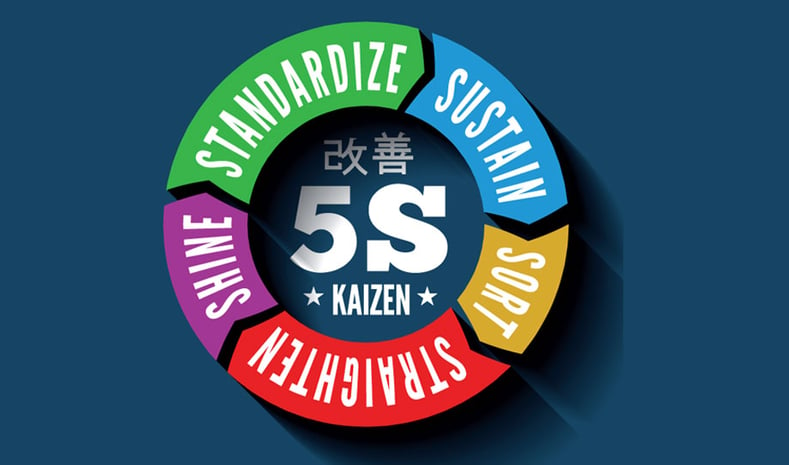
What is The 5S Method?
The 5S Method refers to five Japanese and English terms that begin with an “S” and provide a workplace organization method.
What does each “S” stand for?
- Sort (Seiri): Decide which items in a factory are necessary and which ones are not. Get rid of the ones that are not.
- Straighten (Seiton): Make sure every item in a factory is in the right place. Items should be easy to find and access.
- Shine (Seiso): Clean the factory regularly. By getting rid of dirt, garbage, etc. you can more easily identify problems in the manufacturing process.
- Standardize (seiketsu): Create standards to ensure a clean and neat factory floor.
- Sustain (shitsuke): Create habits that ensure standards are met over the long term. Set responsibilities for managers and operators to ensure that habits are set.
What is SMED?
SMED stands for Single-Minute Exchange or Die. The goal of SMED is to get all changeovers and startups down to 10 minutes. Each step should be one minute or less. By reducing setup time, factories can greatly improve efficiency. SMED as invented by Frederick Taylor in 1911 and was later used by Ford Motors in 1915.
What are the main principles of SMED?
- Identify all changeover tasks.
- Analyze each task to determine purpose.
- Determine low cost solutions.
- Goal should be to reduce changeover time.
What are the steps to implement SMED? The steps to perform SMED are as follows:
- Separate internal from external setup operations
- Convert internal to external setup
- Standardize functions
- Use functional clamps or eliminate fasteners altogether
- Use intermediate jigs
- Adopt parallel operations
- Eliminate adjustments
- Mechanization
32) A3 Problem Solving
Source: sixsigmaconcept.com
What is A3 Problem Solving?
A3 Problem Solving is a problem solving method that uses a structured, continued growth methodology to improve manufacturing practices. The method was invented by Toyota and is based on the work of Edward Deming.
How is A3 Problem Solving implemented?
A3 Problem Solving has 7 steps:
- Determine what is the company generally trying to fix.
- Analyze the current situation. What is currently being done?
- Decide what the company’s goals are. What specifically will be accomplished?
- Determine what the gap is between current processes and where the company wants to be.
- Come up with possible solutions and determine what the barriers will be.
- Decide on a plan. What will the new process look like?
- Follow up. Track results and figure out what’s working.
What is PDCA?
PDCA stand s for Plan-Do-Check-Act and is a four-step method for creating and carrying out change. The PDCA method is a cycle and is repeated over and over again in order to drive continuous improvement.
When is PDCA used?
PDCA is primarily used when:
- Conducting an improvement project.
- Designing a repetitive work process.
- Developing a new process or product design.
- Implementing changes in the manufacturing process.
What are the PDCA steps?
PDCA steps include:
- Plan. Find an area that needs improvement and plan a change.
- Do. Test the change on a small-scale.
- Check. Check how the test went by analyzing the results and determining what you’ve learned.
- Act. Take action based on what you’ve learned. If the change you made did not work, start from the beginning and determine a different test. Use your failures to determine where you will go next.
34) Standardized Work
Source: truenorththinking.ca
What is Standardized Work?
Standardized Work is a tool used to document current best practices, improve the standard, and ensure that the new standard becomes a baseline for improvement.
What does Standardized Work improve?
Standardized Work improves 3 important aspects of the manufacturing process:
- The rate at which products are produced in order to meet customer demand.
- The operator’s work sequence to produce products at that time rate.
- The standard inventory is needed to ensure a smooth manufacturing process.
What are the benefits of Standardized Work? The main benefits of Standardized Work include:
- Better documentation of current processes.
- Easier training for operators.
- Few injuries and strains.
- Baseline to make improvements.
- Reduces variability.
- Adds discipline to a work culture.
- Promotes problem solving.
- Increases teamwork across the organization.
Source: qualityaretegroup.com
What is 5 Whys?
5 Whys is a lean method used to determine the root cause of a problem. Managers repeat the question “Why?” and each answer forms a basis for the next question. This process continues until a conclusion is reached. The 5 Whys technique was developed by Sakichi Toyoda and has been used by Toyota to improve its manufacturing processes. The 5 Whys technique generally requires persistence and determination for it to work effectively.
What are the rules surrounding 5 Whys?
In order to properly perform 5 Whys, managers should follow a variety of rules:
- Use paper or a whiteboard, not a laptop or computer.
- Clearly define the problem and make sure every team member understands it.
- Use a step-by-step process to find the root cause. Avoid jumping to conclusions.
- Identify what the causes are, not the symptoms.
- Use logic, not emotion.
- Focus on making sure answers are as precise as possible.
- Use the customer’s point of view when answering the “Why” questions.
- Facts and knowledge should be the basis for each answer.

Subscribe to Email Updates
Posts by topic.
- Precision Ball (31)
- Engineering Trends (23)
- Procurement Trends (21)
- Custom Bearings (20)
- Medical Manufacturing (20)
- Quality Control (13)
- CNC Machining (12)
- News & Updates (11)
- value engineering (11)
- Bearing Parts (10)

Featured Resources


Top 25 Lean Tools & Techniques

Exploring Lean
There are a lot of great ideas to explore in lean. So, where should you begin?
One way to start is to survey the most important lean tools, with a brief description and a short explanation of how each tool can improve your manufacturing operations.
If a tool captures your interest or resonates with you in some way – explore it further to decide if it is something to pursue now…or later. Many of these tools can be successfully used in isolation, which makes it much easier to get started. On the other hand, the benefits will compound as more tools are used, as they support and reinforce each other.
25 Lean Manufacturing Tools
What is 5s.
5S organizes the work area:
- Sort: eliminate that which is not needed
- Straighten: organize remaining items
- Shine: clean and inspect work area
- Standardize: write standards for above
- Sustain: regularly apply the standards
How does 5S help?
5S eliminates waste that results from a poorly organized work area (e.g., wasting time looking for a tool).
Learn more about 5S
What is Andon?
Andon is a visual feedback system for the plant floor that indicates production status, alerts when assistance is needed, and empowers operators to stop the production process.
How does Andon help?
Andon acts as a real-time communication tool for the plant floor that brings immediate attention to problems as they occur – so they can be instantly addressed.
Learn more about Andon at Vorne.com

Bottleneck Analysis
What is bottleneck analysis.
Bottleneck Analysis identifies which part of the manufacturing process limits the overall throughput and improves the performance of that part of the process.
How does Bottleneck Analysis help?
Bottleneck Analysis improves throughput by strengthening the weakest link in the manufacturing process.
Continuous Flow
What is continuous flow.
Continuous Flow is manufacturing where work-in-process smoothly flows through production with minimal (or no) buffers between steps of the manufacturing process.
How does Continuous Flow help?
Continuous Flow eliminates many forms of waste (e.g., inventory, waiting time, and transport).
Gemba (The Real Place)
What is gemba.
Gemba is a philosophy that reminds us to get out of our offices and spend time on the plant floor – the place where real action occurs.
How does Gemba help?
Gemba promotes a deep and thorough understanding of real-world manufacturing issues – by first-hand observation and by talking with plant floor employees.
Heijunka (Level Scheduling)
What is heijunka.
Heijunka is a form of production scheduling that purposely manufactures in much smaller batches by sequencing (mixing) product variants within the same process.
How does Heijunka help?
Heijunka reduces lead times (since each product or variant is manufactured more frequently) and inventory (since batches are smaller).
Hoshin Kanri (Policy Deployment)
What is hoshin kanri.
Hoshin Kanri aligns the goals of the company (Strategy), with the plans of middle management (Tactics) and the work performed on the plant floor (Action).
How does Hoshin Kanri help?
Hoshin Kanri ensures that progress towards strategic goals is consistent and thorough – eliminating the waste that comes from poor communication and inconsistent direction.
Learn more about Hoshin Kanri
Jidoka (Autonomation)
What is jidoka.
Jidoka is the idea that manufacturers should design equipment to partially automate the manufacturing process (partial automation is typically much less expensive than full automation) and to automatically stop when defects are detected.
How does Jidoka help?
After Jidoka, workers can frequently monitor multiple stations (reducing labor costs) and many quality issues can be detected immediately (improving quality).
Just-In-Time (JIT)
What is just-in-time.
Just-In-Time pulls parts through production based on customer demand instead of pushing parts through production based on projected demand. Relies on many lean tools, such as Continuous Flow, Heijunka, Kanban, Standardized Work, and Takt Time .
How does Just-In-Time help?
Just-In-Time is highly effective in reducing inventory levels. Improves cash flow and reduces space requirements.
Kaizen (Continuous Improvement)
What is kaizen.
Kaizen is a strategy where employees work together proactively to achieve regular, incremental improvements in the manufacturing process.
Learn more about Kaizen
How does Kaizen help?
Kaizen combines the collective talents of a company to create an engine for continually eliminating waste from manufacturing processes.

Kanban (Pull System)
What is kanban.
Kanban is a method of regulating the flow of goods both within the factory and with outside suppliers and customers. Based on automatic replenishment through signal cards that indicate when more goods are needed.
How does Kanban help?
Kanban eliminates waste from inventory and overproduction. Can eliminate the need for physical inventories, instead relying on signal cards to indicate when more goods need to be ordered.
KPIs (Key Performance Indicators)
What are kpis.
KPIs are metrics designed to track and encourage progress towards critical goals of the organization. Strongly promoted KPIs can be extremely powerful drivers of behavior – so it is important to carefully select KPIs that will drive desired behavior.
How do KPIs help?
The best manufacturing KPIs:
- Are aligned with top-level strategic goals (thus helping to achieve those goals)
- Are effective at exposing and quantifying waste (OEE is a good example)
- Are readily influenced by plant floor employees (so they can drive results)
Learn more about Manufacturing KPIs at Vorne.com
Muda (Waste)
What is muda.
Muda is anything in the manufacturing process that does not add value from the customer’s perspective.
How does Muda help?
Muda doesn’t help. Muda means ‘waste’. The elimination of muda (waste) is the primary focus of lean manufacturing.
Overall Equipment Effectiveness (OEE)
What is overall equipment effectiveness.
OEE is a framework for measuring productivity loss for a given manufacturing process. Three categories of loss are tracked:
- Availability (e.g., downtime)
- Performance (e.g., slow cycles)
- Quality (e.g., rejects)
How does Overall Equipment Effectiveness help?
OEE provides a benchmark/baseline and a means to track progress in eliminating waste from a manufacturing process. 100% OEE means perfect production (manufacturing only good parts, as fast as possible, with no downtime).
Learn more about OEE at OEE.com
PDCA (Plan, Do, Check, Act)
What is pdca.
PDCA is an iterative methodology for implementing improvements:
- Plan: establish plan and expected results
- Do: implement plan
- Check: verify expected results achieved
- Act: review and assess; do it again
How does PDCA help?
PDCA applies a scientific approach to making improvements:
- Plan: develop a hypothesis
- Do: run experiment
- Check: evaluate results
- Act: refine your experiment; try again
Poka-Yoke (Error Proofing)
What is poka-yoke.
Poka-Yoke designs error detection and prevention into production processes with the goal of achieving zero defects.
How does Poka-Yoke help?
It is difficult (and expensive) to find all defects through inspection, and correcting defects typically gets significantly more expensive at each stage of production.
Root Cause Analysis
What is root cause analysis.
Root Cause Analysis is a problem solving methodology that focuses on resolving the underlying problem instead of applying quick fixes that only treat immediate symptoms of the problem. A common approach is to ask why five times – each time moving a step closer to discovering the true underlying problem.
How does Root Cause Analysis help?
Root Cause Analysis helps to ensure that a problem is truly eliminated by applying corrective action to the “root cause” of the problem.
Single-Minute Exchange of Die (SMED)
What is single-minute exchange of die.
Single-Minute Exchange of Die reduces setup (changeover) time to less than 10 minutes. SMED techniques include:
- Convert setup steps to be external (performed while the process is running)
- Simplify internal setup (e.g., replace bolts with knobs and levers)
- Eliminate non-essential operations
- Create Standardized Work instructions
How does Single-Minute Exchange of Die help?
SMED enables manufacturing in smaller lots, reduces inventory, and improves customer responsiveness.
Learn more about SMED at Vorne.com
Six Big Losses
What is six big losses.
The Six Big Losses are six categories of productivity loss that are almost universally experienced in manufacturing:
- Setup/Adjustments
- Small Stops
- Reduced Speed
- Startup Rejects
- Production Rejects
How does Six Big Losses help?
The Six Big Losses provide a framework for attacking the most common causes of waste in manufacturing.
Learn more about Six Big Losses at Vorne.com
SMART Goals
What are smart goals.
SMART Goals are: Specific, Measurable, Attainable, Relevant, and Time-Specific.
How do SMART Goals help?
SMART Goals help to ensure that goals are effective.
Standardized Work
What is standardized work.
Standardized Work is documented procedures for manufacturing that capture best practices (including the time to complete each task). It must be “living” documentation that is easy to change.
How does Standardized Work help?
Standardized Work eliminates waste by consistently applying best practices. Forms a baseline for future improvement activities.
What is Takt Time?
Takt Time is the pace of production (e.g., manufacturing one piece every 34 seconds) that aligns production with customer demand. Calculated as Planned Production Time / Customer Demand.
How does Takt Time help?
Takt Time provides a simple, consistent, and intuitive method of pacing production. Is easily extended to provide an efficiency goal for the plant floor (Actual Pieces / Target Pieces).
Learn more about Takt Time at Vorne.com
Total Productive Maintenance (TPM)
What is total productive maintenance.
TPM is a holistic approach to maintenance that focuses on proactive and preventative maintenance to maximize the operational time of equipment. TPM blurs the distinction between maintenance and production by placing a strong emphasis on empowering operators to help maintain their equipment.
How does Total Productive Maintenance help?
TPM creates a shared responsibility for equipment that encourages greater involvement by plant floor workers. In the right environment, this can be very effective in improving productivity (increasing uptime, reducing cycle times, and eliminating defects).
Learn more about TPM at Vorne.com
Value Stream Mapping
What is value stream mapping.
Value Stream Mapping is a tool used to visually map the flow of production. Shows the current and future state of processes in a way that highlights opportunities for improvement.
How does Value Stream Mapping help?
Value Stream Mapping exposes waste in the current processes and provides a roadmap for improvement through the future state.
Visual Factory
What is visual factory.
A Visual Factory uses visual indicators, displays, and controls throughout the manufacturing plant to improve the communication of information.
How does Visual Factory help?
Visual Factory makes the state and condition of manufacturing processes easily accessible and very clear – to everyone.
Learn more about the Visual Factory at Vorne.com
WHAT YOU SHOULD DO NEXT...
1. Learn more about how our product, Vorne XL, can help you eliminate waste and significantly improve OEE.
Vorne XL is the simplest and fastest way to monitor and improve production. It's a one-time cost and takes just a day to install. And you can try it completely free for 90 days.
2. Download our FREE package of tools to supercharge your manufacturing productivity
The package includes leadership lessons, training guides, meeting and report templates, summaries of key concepts, project organizers, and more. You'll also receive our monthly newsletter for free. Unsubscribe at any time.
3. Sign up for our monthly newsletter
Get free monthly updates with proven methods for improving our manufacturing productivity. Unsubscribe at any time.
Lean Six Sigma Training Certification
- Facebook Instagram Twitter LinkedIn YouTube
- (877) 497-4462

Lean Problem Solving Techniques. The Definitive Guide to Operational Excellence
October 1st, 2024
In today’s fast-paced business world, efficiency isn’t just an advantage — it’s a necessity. This powerful methodology isn’t just a tool; it’s the secret weapon that sets successful companies apart from their competitors.
Whether you’re a seasoned business professional, a project manager looking to streamline operations, or a process improvement enthusiast eager to make a difference, this comprehensive guide to lean problem-solving will equip you with the knowledge and skills you need to drive meaningful change in your organization.
But we won’t stop at theory. Drawing from my extensive experience, I’ll share real-world case studies and practical examples that illustrate the transformative power of lean problem-solving . We’ll also look ahead to the future, exploring how emerging technologies and trends are shaping the evolution of this critical business skill.
What is Lean Problem Solving?
I’ve seen firsthand how lean problem-solving can revolutionize businesses across various industries. But what exactly is lean problem solving, and why is it so crucial in today’s fast-paced business environment?
Lean problem-solving is a systematic, data-driven approach to identifying, analyzing, and resolving issues within an organization. It’s not just about fixing problems; it’s about creating a culture of continuous improvement . At its core, lean problem-solving is about maximizing value while minimizing waste .
The roots of lean problem-solving trace back to the Toyota Production System (TPS) developed in the mid-20th century.
The key principles of lean problem-solving include:
- Focus on customer value
- Identify and eliminate waste
- Continuous improvement (Kaizen)
- Respect for people
- Make decisions based on long-term philosophy
These principles form the foundation of what we call “problem-solving lean” – a methodology that’s transforming how businesses approach challenges.
As a chemical engineer who’s worked extensively with manufacturing giants like 3M and Dell, I’ve seen how these principles, originally designed for manufacturing efficiency, have evolved into a versatile problem-solving methodology applicable across various sectors.
Benefits of Lean Problem Solving
The benefits of adopting lean problem-solving techniques are substantial:
- Increased efficiency : By eliminating waste, organizations can streamline processes and boost productivity.
- Improved quality : Lean methodologies focus on reducing defects and variability , leading to higher quality outputs.
- Enhanced customer satisfaction : By focusing on value from the customer’s perspective, businesses can better meet and exceed customer expectations.
- Cost reduction : Eliminating waste and improving efficiency naturally leads to cost savings.
- Empowered workforce : Lean problem-solving encourages employee involvement, leading to higher engagement and job satisfaction.
In my work with companies like GE and HP, I’ve seen these benefits translate into tangible results. For instance, one manufacturing client reduced their product development cycle time by 40% after implementing lean problem-solving methods.
Lean problem-solving differs from traditional problem-solving approaches in its focus on continuous improvement and waste elimination . While traditional methods might focus on quick fixes, lean problem-solving aims to address root causes and create sustainable solutions.

Key Lean Problem-Solving Techniques
In this section, I’ll share some of the most effective lean problem-solving methods I’ve encountered and applied throughout my career. These techniques form the backbone of practical problem-solving in lean management and are crucial for anyone looking to master lean Six Sigma problem-solving.
The 5 Whys is a fundamental lean problem-solving technique that I’ve found incredibly effective in uncovering root causes. It’s a simple yet powerful tool that involves asking “Why?” repeatedly to dig deeper into a problem.
How it works
- State the problem
- Ask why the problem occurs and write down the answer
- If the answer doesn’t identify the root cause, ask “Why?” again
- Repeat the process five times or until you’ve identified the root cause
Example from my experience
While working with a major electronics manufacturer, we faced recurring quality issues with a new product line. Here’s how we applied the 5 Whys :
- Why are we seeing defects in the final product? Because the circuit boards are faulty.
- Why are the circuit boards faulty? Because they’re not soldered correctly.
- Why aren’t they soldered correctly? Because the soldering temperature is inconsistent.
- Why is the soldering temperature inconsistent? Because the soldering equipment is outdated and poorly maintained.
- Why is the equipment outdated and poorly maintained? Because there’s no regular maintenance schedule or budget for equipment upgrades.
This process led us to implement a robust maintenance schedule and allocate a budget for equipment upgrades, solving the quality issues at their root.
A3 Problem Solving
A3 problem-solving is a structured problem-solving and continuous improvement approach that I’ve found particularly useful in lean management problem solving. It’s named after the A3-sized paper used to document the process.
Key components of A3
- Problem Statement
- Current Condition
- Goal/Target Condition
- Root Cause Analysis
- Countermeasures
- Implementation Plan
- Follow-up Actions
I’ve successfully used A3 in various scenarios, from improving manufacturing processes to optimizing supply chain operations at a computer hardware and software manufacturer. The visual nature of A3 makes it an excellent tool for communicating complex problems and solutions across teams.
The Plan-Do-Check-Act (PDCA) cycle is a four-step lean problem solving process that I’ve found invaluable in lean manufacturing problem solving. It’s an iterative approach that promotes continuous improvement.
Steps in PDCA
- Plan : Identify and analyze the problem
- Do : Develop and implement a solution
- Check : Evaluate the results
- Act : Standardize the solution if successful or begin the cycle again
In my work with GE, we used PDCA to improve a production line’s efficiency. We planned process changes, implemented them on a small scale, checked the results, and then acted to roll out successful changes across the entire line. This iterative approach led to a 30% increase in productivity.
Fishbone Diagram
Also known as the Ishikawa diagram, the fishbone diagram is a visual lean problem-solving technique that I’ve found it particularly useful in brainstorming sessions . It helps teams identify potential causes of a problem across different categories.
How to create a fishbone diagram
- Define the problem (the “head” of the fish)
- Identify major categories of potential causes (the “bones”)
- Brainstorm potential causes within each category
- Analyze the results to identify the most likely root causes
I’ve used this technique extensively in Six Sigma problem-solving, particularly when dealing with complex quality issues that have multiple potential causes.
Value Stream Mapping
Value Stream Mapping (VSM) is a lean tool that helps visualize the steps in a process and identify areas of waste. It’s particularly useful in lean manufacturing problem-solving and process improvement.
Key steps in VSM
- Select a product family
- Create a current state map
- Identify areas of waste
- Create a future state map
- Develop an implementation plan
During a project, we used VSM to streamline a complex production process, reducing lead time by 40% and improving quality by eliminating non-value-adding steps.

These lean problem-solving techniques form the core of effective lean Six Sigma problem-solving. By mastering these methods, you’ll be well-equipped to tackle complex business challenges and drive continuous improvement in your organization.
Ready to master these powerful Lean problem-solving techniques ? Take your skills to the next level with our Lean Fundamentals course that covers these techniques and more.
Implementing Lean Problem Solving in Your Organization
I’ve learned that successful implementation is as much about culture change as it is about methodology. In this section, I’ll share my insights on how to effectively integrate lean problem-solving into your organization’s DNA.
Creating a Lean Culture
The foundation of successful lean problem-solving implementation is a culture that embraces continuous improvement. Here’s how to foster this culture:
- Lead by example : As a leader, your commitment to lean principles sets the tone for the entire organization. I’ve seen firsthand how executive buy-in at companies like Intel and Motorola drove successful lean transformations.
- Encourage open communication : Create an environment where employees feel safe to identify problems and suggest improvements. At 3M, we implemented a “no-blame” policy that significantly increased problem reporting and resolution.
- Celebrate small wins : Recognize and reward teams for their problem-solving efforts, no matter how small. This reinforces the value of continuous improvement .
- Make it visible : Use visual management tools like lean problem-solving boards to make progress and challenges visible to everyone.
Training Your Team
Effective lean problem solving training is crucial for successful implementation. Based on my experience developing Six Sigma deployment strategies, here’s what I recommend:
- Start with the basics : Ensure everyone understands the fundamental concepts of lean and Six Sigma problem-solving.
- Provide hands-on experience : Use real-world problems from your organization in training sessions. This approach worked wonders when I led workshops for engineers and process developers at Xerox.
- Develop internal champions : Identify and train individuals who can become internal experts and advocates for lean problem-solving.
- Offer ongoing education : Lean problem-solving is a journey, not a destination. Continual learning opportunities keep skills sharp and methodologies up-to-date.
Establishing Problem-Solving Processes
To make lean problem-solving a part of daily operations, you need clear, standardized processes:
- Define trigger points : Establish criteria for when to initiate formal problem-solving processes.
- Create standard templates : Develop A3 or other problem-solving templates that guide teams through the process consistently.
- Set up regular review meetings : Schedule frequent check-ins to review progress and provide support.
- Integrate with existing systems : Ensure lean problem-solving methods complement your existing project management tools , whether it’s Jira for lean problem-solving or other platforms.
Overcoming Common Challenges
In my international consulting work, I’ve encountered several recurring challenges in lean problem-solving implementation. Here’s how to address them:
- Resistance to change : Communicate the benefits clearly and involve employees in the process. When I worked with HP, we formed cross-functional teams to drive change from within.
- Lack of time : Start small and demonstrate how lean problem-solving saves time in the long run. At Seagate, we began with pilot projects that showed quick wins.
- Data overload : Focus on collecting only the most relevant data. I’ve helped many organizations streamline their data collection processes to avoid analysis paralysis.
- Sustaining momentum : Regular check-ins, continuous training, and visible progress tracking help maintain enthusiasm and commitment.
- Engagement : Downloadable Lean Problem-Solving Implementation Checklist
To help you get started, I’ve created a comprehensive checklist based on my years of experience implementing lean problem-solving across various industries.

Remember, implementing lean problem-solving is not a one-time event, but a continuous process of improvement . It requires patience, persistence, and a willingness to learn and adapt. But the rewards – increased efficiency, improved quality, and a more engaged workforce – are well worth the effort.
Lean Problem Solving Across Industries
In this section, I’ll share my insights on how lean problem-solving adapts and thrives in different industrial contexts.
Manufacturing
Manufacturing was the birthplace of lean methodologies , and it remains a powerhouse for lean problem-solving applications. During a project for an industrial manufacturer, I spearheaded numerous lean manufacturing problem-solving initiatives that yielded significant results.
Case Study : At a plant producing adhesive products, we implemented a lean problem-solving process focused on reducing waste in the coating line. Using the 5 Whys technique, we uncovered that inconsistent raw material quality was a root cause of excessive scrap. By working with suppliers and implementing stricter quality controls, we reduced scrap by 35% and increased productivity by 20%.
Key Challenges in Manufacturing
- Complex supply chains
- High-volume production with low margins
- Stringent quality requirements
The healthcare industry has embraced lean problem-solving methods to improve patient care, reduce costs, and enhance operational efficiency . My work with several hospitals has shown the transformative power of lean in this critical sector.
Case Study : At a large urban hospital, we used Lean Six Sigma problem-solving to address long emergency room wait times. Through value stream mapping , we identified several non-value-adding steps in the patient intake process. By streamlining these processes and implementing a new triage system, we reduced average wait times by 40% and improved patient satisfaction scores significantly.
Key Challenges in Healthcare
- Regulatory compliance
- Patient safety concerns
- Resistance to change in established medical practices
Software Development
The fast-paced world of software development has adapted lean principles to create methodologies like Agile and Scrum. During my collaborations with tech companies like Intel and HP, I’ve seen how lean problem solving can accelerate development cycles and improve product quality.
Case Study: At a leading software company, we applied lean problem-solving techniques to their development process. By implementing daily stand-up meetings (a core component of Scrum) and using Kanban boards (a lean tool for visualizing workflow), the team reduced bug rates by 30% and shortened release cycles by 25%.
Key Challenges in Software Development
- Rapidly changing technology landscapes
- Balancing innovation with stability
- Managing distributed teams
Service Industries
Service industries, from finance to hospitality, have found innovative ways to apply lean problem solving. My experience with service-oriented companies has shown that lean principles can significantly enhance customer satisfaction and operational efficiency.
Case Study: For a major bank, we used lean management problem-solving to improve their customer service call center operations. By applying the PDCA (Plan-Do-Check-Act) cycle , we identified and eliminated several redundant processes. This led to a 20% reduction in average call handling time and a 15% increase in customer satisfaction scores.
Key Challenges in Service Industries
- Intangible nature of services
- High customer interaction
- Variability in demand

Now, let’s put your lean problem-solving skills to the test. Consider the following scenario:
A mid-sized e-commerce company is struggling with a high rate of returns for their products. Using the lean problem-solving methods we’ve discussed, how would you approach this issue?
- What lean problem-solving technique would you start with and why?
- What data would you collect to understand the problem better?
- How would you involve different departments in the problem-solving process?
- What potential solutions might you consider based on lean principles?
Take a moment to think through these questions. This exercise will help you apply lean problem-solving techniques to a real-world scenario, much like the challenges I’ve faced in my consulting work across various industries.
As we’ve seen, lean problem-solving is a versatile methodology that can be adapted to virtually any industry. Whether you’re in manufacturing, healthcare, tech, or services, the principles of lean can help you identify root causes, eliminate waste , and continuously improve your processes.
Ready to become an expert in advanced lean problem-solving methodologies? Get started with our Lean Master course to drive lean projects and boost organizational growth.
Integrating Lean Problem-Solving with Other Methodologies
One of the most exciting developments I’ve observed and contributed to is the integration of lean problem-solving with other powerful methodologies. This synergy has led to even more effective and versatile approaches to tackling complex business challenges.
In this section, I’ll share my insights on how lean problem-solving can be combined with other popular methodologies to create robust, holistic problem-solving frameworks . I’ll demonstrate how these integrated approaches can drive unprecedented levels of efficiency and innovation.
Lean Six Sigma
Lean Six Sigma is a methodology I’m particularly passionate about, as it combines the waste-reduction focus of lean with the variation-reduction power of Six Sigma. This integration creates a formidable problem-solving approach that I’ve successfully implemented in numerous organizations.
Key synergies
- Lean’s focus on eliminating waste complements Six Sigma’s emphasis on reducing variation
- Both methodologies prioritize data-driven decision-making
- The DMAIC framework of Six Sigma provides a structured approach to lean problem solving
How to combine effectively
- Use lean tools like Value Stream Mapping to identify areas of waste
- Apply Six Sigma statistical tools to analyze and reduce variation in these areas
- Implement lean solutions and monitor results using Six Sigma control charts
We used this integrated approach to reduce defects in a manufacturing process by 70% while simultaneously increasing throughput by 25%.
The integration of lean problem-solving with Agile methodologies has revolutionized project management, particularly in software development and IT. As someone who has led numerous international projects, I’ve seen firsthand how this combination can dramatically improve project outcomes.
- Both emphasize iterative improvement and flexibility
- Agile’s sprint cycles align well with Lean’s PDCA (Plan-Do-Check-Act) cycle
- Both methodologies prioritize customer value
- Use lean problem-solving techniques like the 5 Whys in sprint retrospectives
- Implement lean visual management tools like Kanban boards in Agile workflows
- Apply lean waste reduction principles to streamline Agile processes
During a project, we integrated lean problem-solving into their Agile development process, resulting in a 30% reduction in time-to-market for new products.
Design Thinking
Design Thinking, with its focus on user-centric innovation, can be powerfully enhanced by lean problem-solving techniques. This combination has proven particularly effective in my work with product development teams.
- Both methodologies emphasize understanding user needs
- Lean’s efficiency focus complements Design Thinking’s innovation emphasis
- Both approaches encourage prototyping and iterative improvement
- Use lean problem-solving tools like the Fishbone Diagram in the Define stage of Design Thinking
- Apply lean principles to streamline the prototyping process in Design Thinking
- Incorporate lean metrics into the testing phase of Design Thinking
At a computer hardware and software manufacturer, we integrated lean problem-solving into their Design Thinking process , leading to a 40% reduction in product development cycle time and a significant increase in customer satisfaction scores.

This diagram highlights the key principles shared by lean problem solving, Six Sigma , Agile, and Design Thinking, as well as their unique contributions. By understanding these intersections, you can create a tailored problem-solving approach that leverages the strengths of each methodology.
Measuring Success and ROI of Lean Problem Solving
I’ve learned that implementing lean problem-solving techniques is only half the battle. The other crucial half is measuring the success and demonstrating the return on investment (ROI) of these initiatives.
I’ve developed robust methods for quantifying the impact of lean problem-solving efforts. In this section, I’ll share my insights on how to effectively measure and communicate the value of your lean problem-solving initiatives.
Key Performance Indicators (KPIs)
Selecting the right KPIs is crucial for tracking the success of your lean problem solving efforts. Based on my experience, here are some essential metrics to consider:
- Cycle Time : Measures the time taken to complete a process from start to finish.
- First Time Yield : Tracks the percentage of units produced correctly the first time without rework.
- Defect Rate : Monitors the number of defects per million opportunities (DPMO ).
- Cost of Poor Quality (COPQ) : Quantifies the costs associated with producing defective products or services.
- Employee Engagement : Measures the level of employee involvement and satisfaction with the lean problem-solving process.
We implemented these KPIs to track our lean manufacturing problem-solving initiatives. This allowed us to demonstrate a 30% reduction in cycle time and a 25% improvement in first-time yield within the first year of implementation.
Calculating ROI
Calculating the ROI of lean problem-solving initiatives is essential for gaining and maintaining stakeholder support. Here’s a simple formula I’ve used successfully:
ROI = (Gains from improvement – Cost of improvement) / Cost of improvement x 100%
To effectively calculate ROI:
- Quantify all costs associated with the lean problem-solving initiative, including training, tools, and time investment.
- Measure the financial gains from improvements, such as reduced waste, increased productivity, or higher quality output.
- Use the formula to calculate the percentage return on your investment.
For example, in a project, we invested $500,000 in lean problem solving training and implementation . The resulting improvements led to annual savings of $2 million. Using our formula:
ROI = ($2,000,000 – $500,000) / $500,000 x 100% = 300%
This compelling 300% ROI helped secure ongoing support for our lean initiatives from top management.
Long-term Impact Assessment
While immediate results are important, the true value of lean problem-solving often manifests in long-term benefits. Here are some approaches I’ve used to assess long-term impact:
- Trend Analysis : Track KPIs over extended periods to identify sustained improvements.
- Cultural Shifts : Assess changes in organizational culture, such as increased employee problem-solving capabilities and proactive improvement mindsets .
- Competitive Advantage : Evaluate market share gains or improved customer satisfaction over time.
Remember, measuring the success and ROI of lean problem-solving is not just about numbers. It’s about telling a compelling story of continuous improvement and value creation.

By effectively tracking KPIs, calculating ROI, and assessing long-term impact, you can demonstrate the tangible benefits of lean problem-solving to all stakeholders in your organization.
Take your problem-solving and leadership skills to the highest level and become a catalyst for organizational transformation. Enroll in our Lean certification programs today!
The Future of Lean Problem Solving
Now, as we look ahead, I see transformative changes on the horizon that will reshape how we approach problem-solving in the coming years.
Integration with AI and Big Data
The convergence of lean problem-solving techniques with artificial intelligence and big data analytics is perhaps the most significant trend I’m observing. This integration is set to revolutionize how we identify, analyze, and solve complex business problems.
Key developments
- Predictive Problem Solving : AI algorithms can anticipate potential issues before they occur, allowing for proactive problem-solving.
- Enhanced Root Cause Analysis : Machine learning can process vast amounts of data to identify patterns and root causes that might be invisible to human analysts.
- Automated Lean Tools : AI-powered versions of traditional lean tools like the 5 Whys or Fishbone Diagrams can provide deeper insights and suggestions.
In a recent project with a major tech company, we implemented an AI-driven lean problem solving system that reduced defect rates by 40% and improved overall equipment effectiveness by 25%.
Adapting to Remote and Hybrid Work Environments
The shift towards remote and hybrid work models is challenging traditional lean problem-solving processes. However, it’s also opening up new opportunities for innovation and efficiency.
Emerging trends
- Virtual Lean Problem Solving Boards : Digital platforms that replicate the functionality of physical boards, enabling real-time collaboration across distributed teams.
- Remote Gemba Walks : Using augmented reality (AR) technology to conduct virtual site visits and observations.
- Asynchronous Problem Solving : Developing lean problem-solving methods that accommodate different time zones and work schedules.
During the pandemic, I helped a manufacturing client implement a virtual lean problem solving process that maintained productivity levels despite having 70% of their workforce remote.
Sustainability and Environmental Considerations
As the global focus shifts toward sustainability, lean problem solving is evolving to incorporate environmental considerations into its core principles.
- Green Value Stream Mapping : Incorporating environmental impact metrics into traditional value stream maps.
- Circular Economy Problem Solving : Applying lean techniques to design waste out of systems and promote recycling and reuse.
- Carbon Footprint Reduction : Using lean problem solving methods to optimize processes for minimal environmental impact.
In problem-solving with an automotive supplier, we used Lean Six Sigma problem-solving techniques to reduce their carbon footprint by 30% while simultaneously improving production efficiency.
To prepare for these future developments, I recommend
- Investing in AI and data analytics training for your lean practitioners
- Developing digital literacy skills across your organization
- Incorporating sustainability metrics into your lean problem-solving processes
As we navigate these exciting developments, it’s clear that the core principles of lean problem solving – eliminating waste , focusing on customer value, and continuous improvement – will remain as relevant as ever. The challenge and opportunity lie in adapting these principles to new technologies and global priorities.
As we wrap up this comprehensive exploration of lean problem-solving, I’m reminded of a pivotal moment early in my career.
At an industrial manufacturing organization, we were facing a seemingly insurmountable manufacturing challenge, and it was through the application of lean problem-solving techniques that we not only overcame the issue but revolutionized our entire production process.
This experience solidified my belief in the power of lean methodologies , a belief that has only grown stronger over my 20 years as a Six Sigma Master Black Belt.
The value of lean problem-solving cannot be overstated. It provides a structured, data-driven approach to tackling complex challenges, driving continuous improvement , and fostering a culture of innovation .
As we’ve seen, lean problem-solving is not just a set of tools or techniques – it’s a mindset. It’s about seeing opportunities for improvement in every process, empowering every team member to contribute to problem-solving efforts, and never being satisfied with the status quo. This mindset, when fully embraced, can transform not just individual processes, but entire organizations.
SixSigma.us offers both Live Virtual classes as well as Online Self-Paced training. Most option includes access to the same great Master Black Belt instructors that teach our World Class in-person sessions. Sign-up today!
Virtual Classroom Training Programs Self-Paced Online Training Programs
SixSigma.us Accreditation & Affiliations

Monthly Management Tips
- Be the first one to receive the latest updates and information from 6Sigma
- Get curated resources from industry-experts
- Gain an edge with complete guides and other exclusive materials
- Become a part of one of the largest Six Sigma community
- Unlock your path to become a Six Sigma professional
" * " indicates required fields
Lean Manufacturing Tools
Lean manufacturing tools, techniques and philosophy | lean and related business improvement ideas.

Top 50 Lean Tools | Comprehensive List for Lean Manufacturing and Service
Full list of lean manufacturing tools.
There are many Lean Manufacturing Tools and other ideas and principles that are associated with Lean. Most of these tools should be implemented within the main principles of Lean and as part of a clearly defined and planned roll out to improve your business.
Each of the tools can be implemented on its own, however, the greatest value will always come as part of a comprehensive implementation of lean. These tools are suitable for all forms of businesses and can be applicable to both manufacturing and service companies.
The following are some of the most important lean tools that you should implement and use within your business:
Top 50 Lean Tools
Standardized work.
Standard Operating Instruction
Standardized operations are required before you start anything else. If there is no clear and agreed way of performing the work then you have a vast opportunity for variation between how the work will be done. Processes should be agreed, documented, and controlled to ensure that we perform them in the most effective way every time. Standardized work provides us with a baseline from which we can start to make improvements. If there is no agreed way of working then you cannot know if any changes you have made are responsible for any improvements.
5S is probably the most well-known Lean Tool and is often the first implemented when a company starts their lean journey. It is simply a way of providing you with a workplace that is clutter free and organized in a way that provides for efficient, safe and ergonomic working. Typical efficiency gains of 10% to 30% are usually realized through an implementation of this tool, often without having any major expenditure. It is known as 5S because of the 5 stages that all start with S in Japanese:
- Seiri or Sort .
- Seiton or Straighten .
- Seiso or Sweep .
- Seiketsu or Standardize .
- Shitsuke or Sustain .
TPM – Total Productive Maintenance
Having machines and processes that you can rely on is vital for any business. Total Productive Maintenance (TPM) is a fully inclusive approach to maintenance that seeks to prevent any issues from occurring in the first place. It builds on the principles of preventative maintenance and uses the skills and knowledge of those that actually operate the processes and machines and does not simply rely on engineers and fitters. To find out more about TPM just click this link: Total Productive Maintenance .
6 Big Losses
Within any TPM implementation you must understand the reasons for any loss of your productivity. This is defined through looking at the 6 big losses:
- Breakdowns of your machines and processes
- Setups: this planned down time of the process due to changeovers and setups
- Stoppages: these are the short stoppages that are made due to minor issues
- Reduced speed: running at less than the design speed for the process
- Defects: these are the scrap or defective parts that may be turned out by the process
- Setup Scrap: these are the defective parts produced when setting up the process
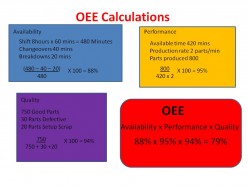
OEE Calculation
Overall Equipment Effectiveness ( OEE ) is the measure used within TPM to measure a processes’ overall availability, performance and quality. It is a composite measure made up through measuring each of the 6 big losses and can be used to direct your problem solving initiatives.
This is the “real place” in Japanese and within Lean we mean the actual place in which value is created in our work processes. Unless a manager or engineer actually visits the place in which the work is being done and questions the process it will be impossible to fully understand and improve it. It is important that all take the time to observe and question the processes at the Gemba.
Visual Management – Visual Workplace
You should aim to implement the visual factory; this is one in which it is obvious at a glance as to how things work and flow. It ensures clear communication of information within the workplace as well as highlighting in an obvious manner if something abnormal has occurred.
Andon lights or flags are signals that are used within the workplace to highlight when something abnormal has occurred such as a machine breakdown. A red light and even a siren could be used to call immediate attention to the issue for action by the responsible persons. They ensure real time communication of issues and an immediate response.
Muda – 7 Wastes of Lean
7 Wastes of Lean
Muda within lean is defined as any activity or process that does not add value. You must understand what they are if you are to be able to eliminate them from your processes. These are generally characterized through the 7 wastes of lean (remember using the simple acronym – TIMWOOD):
- Over-Processing
- Over-Production
In addition you may also consider:
- Waste of talent
- Waste or resources
- Waste of by-products
Mura – Unevenness
Mura is the waste of unevenness or inconsistency within what we do. This manifests as uneven work demand that may drive the creation of Muda with regards to inventory and over production. It places unfair demand on both employees and the processes themselves and is one of the root causes of waste within your processes.
Muri – Overburden
Muri is overburden of your processes and employees and again drives the creation of Muda. Muri is unnecessary stress that is caused by poor instructions, lack of training, and inappropriate tools to name just a few causes.
Added Value
Value Adding Processes
Value needs to be understood if you are to drive out waste from your business. It can be defined as something that your customer will be happy to be paid for with regard to your product or service. If they would be unhappy to pay for it then it has no value and should be driven out.
Kaizen is “Change for the better” and is seen as the lean process for continual improvement of all that we do. It is not correcting issues when they occur but seeking to actually improve our processes to make them more efficient and to prevent any possibility of defects. This is a team process usually led by supervisory staff to make steady incremental improvements to quality and performance.
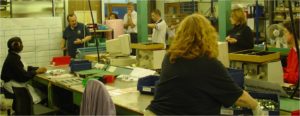
Kaizen Event
This is a kaizen breakthrough event that is run to make a significant improvement to a process within a short space of time. Unlike standard kaizen which seeks to make incremental improvements the event approach is designed to make a major impact on how a process performs. Typically it will be performed by a multifunctional team, including people from the target area. They will focus on the area with no need to worry about other day to day tasks.
7 Quality tools
Quality Tools
There are seven quality tools that have been traditionally used to help with data collection and problem solving, although many more have been added over the years. These include all of the following:
- Tally Sheets
- Pareto diagrams
- Ishikawa or Fishbone Diagrams
- Process Control Charts
- Process Mapping
- Brainstorming
Just in Time – JIT
Just in Time production is one of the main pillars of Lean manufacturing. It is the principle of producing what the customer wants, in the quantity that they require, when they want it, and where they want it, without delays or waste. It specifically seeks to remove inventory from your processes.
Inventory Reduction
Inventory driven by over-production is often by far the worst waste in your business, as well as tying up a significant amount of cash. It prevents us being able to provide our customers products through Just in Time. Reduction of our inventory is vital to being able to make improvements in our processes.
Continuous flow – Single piece flow
The ideal process is one in which product flows one at a time from operation to operation without delays or stocks between any operations. By implementing continual flow you will immediately highlight any issues within the process as well as reducing the need to hold high levels of work in progress stock.
Pull System
In traditional manufacturing, demand is forecast and batches of product are pushed through the production processes. This leads to large levels of stocks and work in progress as well as the potential of producing product that will never be ordered. With pull production you take from production what the customer orders only and it is built on demand.
Kanban Systems
Kanban is how many companies, such as Toyota, control their pull production. Typical Kanbans are cards, containers or even physical spaces within the factory. Production only takes place when there are containers, spaces or cards that signal that the part should be made. Typically goods are taken from the end of the line which signals earlier processes through the Kanban to produce more.
Cellular Manufacturing
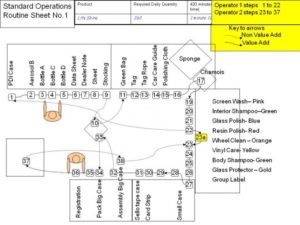
Cell Manufacturing
A traditional manufacturing plant has its machines arranged in “silos”. They will have for instance a welding area, a moulding area, a machining area, and so forth. Large batches of materials are then moved from silo to silo. Cellular manufacturing however seeks to place all of the required processes and tools within one working call dedicated to a single product or family of products. This self-contained cell then can produce those products from start to finish using a simple pull system.
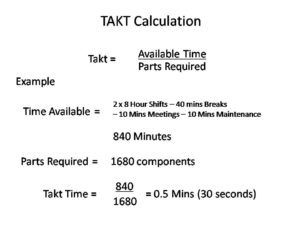
TAKT Time Calculation
Takt is the “beat of the drum” by which your processes should operate. It is the average time in which you need to complete a product. The Takt time dictates the rate at which each process within your company should operate to avoid bottlenecks and over production of components and finished goods.
Product Family Analysis
This is a study undertaken to identify which products utilize which processes within the company. It is used to identify products that can be grouped as families as they share similar process flows. This enables you to set up cells and lines that will be suitable for a family of products.
One of the biggest of the seven wastes if Over-Production and the resulting Inventory. Excessive inventory masks many problems within your processes and can cause you to tie up vast amounts of your cash. To achieve continual flow and pull production these inventory levels must be reduced to the absolute minimum possible.
Heijunka is the process of levelling the workload within the company to remove the waste of Mura or unevenness. We seek to ensure that the whole of your production process will operate at the Takt time of the business.
Yamazumi Boards
A Yamazumi board or chart allows you to visualize all of the time taken within your operations. It is a tool that allows you to “stack up” all of the component times and to balance how long each step in your cells will take. This allows you to achieve the smooth flow required for your processes.
Lead Time Reduction
The time from order to delivery is something that is very important to most customers. Today it is often the company that is able to deliver the quickest that is going to win the order rather than the cheapest. Being able to improve all aspects of your process from the back office processing and design through to your final delivery is vital in reducing your lead times.
SMED – Single Minute Exchange of Die
Single Minute Exchange of Die
One of the most valuable tools for reducing the time spend on changeovers or setups is that of Single Minute Exchange of Die or SMED. It literally seeks to ensure that you can changeover your processes in less than 10 minutes. Using SMED ensures that processes that once took a day to changeover are done within minutes allowing you to not only to utilize your equipment more effectively but also to reduce batch sizes to a minimum for continual flow.
Jidoka – Built in Quality
Jidoka is the principle of “Built in Quality” or “Quality at Source” and is one of the main pillars of Lean production. Within everything that we do we should seek to ensure that it is done precisely as it should be. Poor quality product or service can sink a company very quickly. Jidoka seeks us to look for ways to ensure that every process can only turn out conforming product. We aim for “Right First Time” in all that we do.
Taguchi Loss Function
This was developed by Genichi Taguchi who showed that satisfaction and dissatisfaction are not simply black and white based on a product being within specifications. The taguchi loss function basically shows us that the chances of a customer being satisfied with a product are higher if the product is within specifications while their chances of being dissatisfied become higher the further away from nominal you become.
Poka Yoke is a method of error proofing. Visual inspection is time consuming and often highly ineffective so we use Poka Yoke methods to automatically detect or prevent the creation of defects within our processes. Processes themselves highlight the defects or will not accept them.
Autonomation
Autonomation is a phrase coined within Toyota that means “Automation with a human touch.” They seek to design machines within which repetitive or difficult tasks are automated but the processes themselves are still monitored by human beings. The people only need to intervene when something out of the ordinary has occurred.
One of the first steps in Jidoka is to STOP. If you are producing non-conforming product then you do not just carry on doing so. Personnel are provided the authority to stop the process and even the whole line. This motivates everyone involved to become quickly involved to resolve the issue rather than just building a mountain of scrap or product for later rework.
5 Whys – Root Cause Analysis
Far too often when we “fix” a problem all we do is to deal with one of the symptoms of a bigger underlying issue. We must seek to drive our problem solving to the true root cause of the problem and fix that. Asking “Why” 5 times in a row will often help us to focus in on what that root cause may be.
People are one of your greatest assets no matter what your business is, and are one of the main pillars of lean. Without their creativity and hard work it will be hard to succeed and to compete in any business. You must always value and develop your teams to ensure that you get the best from them.
Self-Directed Work Teams
These are teams of individuals within the workplace that have a multitude of different skills. They are empowered to make changes and improvements within their area with a goal to make the processes better and to avoid issues.
Team Building
Management’s role within self-directed work teams is one in which they should be coaching and developing the teams rather than directing their every action. Their aim should be to build a cohesive team that is able to achieve the goals that are set for them.
Empowerment
A team that has no real control or authority over their work place is unlikely to be able to make the improvements and changes that are required. A team must be given the authority and any necessary funding to be able to truly be effective at what they are doing.
Cross Training
Within any team it is important that members fully understand each other’s roles and in many instances need to be able to undertake those roles. This enables a much higher degree of flexibility from the team allowing them to cover each other’s functions as required as well as enhancing any problem solving and improvement initiatives.
Hoshin Kanri – Policy Deployment
This is about setting overall goals for the business and then deploying and aligning those goals throughout the business. It requires you to take your business strategy and to translate it into objectives that are cascaded down through the business. A review process is then put in place to ensure that these goals are met.
Supplier Relationships
The traditional relationship between an organization and its suppliers is one in which the company wants the lowest possible price and the supplier wants the highest and each will fight and maneuver to try to achieve their goals. Far better that they develop a mutual cooperation so that the success of both companies is shared. Often this involves “open book” sourcing and a full sharing of knowledge between the companies.
Value Stream Mapping
Value Stream Mapping (VSM) is a powerful method to visualize the flows and wastes within your processes. As a tool it can be used to highlight where action is required within the process as well as providing you with a target to aim for through your future state value stream map .
Bottle Neck Analysis
No matter how fast individual machines may be your overall process will only ever flow as fast as the slowest part of the chain. It is vital to identify and improve the bottlenecks that restrict your flow to improve them if you require a faster flow through the process.
KPI – Key Performance Indicators
Key Performance Indicators are metrics that the company uses to provide goals and targets for all aspects of their business. These should be aligned from the top level company strategy through to what should be achieved within individual cells. KPIs have a huge impact over behavior so they should be chosen with care to ensure that you foster the correct behavior within your company.
SMART Goals
Goals need to be written in a way that allows them to be effective. They should be:
- Specific: it should be clear as to what the goal refers to.
- Measurable: you must be able to know when you have reached the goal.
- Achievable: the goal should not be something that can never be reached.
- Relevant: it should be something that is important.
- Time Limited: it should be clear when the goal should be reached.
Continuous Improvement
You may be the best at what you do today. However, there will always come a time when someone will become better at doing what you do and they have a chance to snatch away your business. You cannot afford to sit still with anything that you do. You must always strive to continually improve all aspects of what you do.
PDCA – PDSA
Plan Do Check Act
Plan, Do, Check, Act (PDCA) is the simplest improvement cycle and is often know as either the Deming cycle or the Shewhart cycle after the quality Gurus that invented and pushed its implementation. This is a continual cycle for improvement and should be repeated over and over to ensure that you continuously improve your processes. Also known as PDSA – Plan, Do, Study, Act.
DMAIC is a variation on PDCA introduced through 6 sigma. The steps are:
- Define: outline the process, the boundaries for your study and the expectations.
- Measure: collect data on the current state of the process.
- Analyze: show the gaps between the goal and current performance and identify the causes.
- Improve: design and implement solutions to close that gap.
- Control: put in place changes that prevent the process slipping back into its old ways.
TQM – Total Quality Management
Total Quality Management puts the focus very much on what the customer wants and how you will achieve it. First implemented within Bell Telephone Laboratories by Walter Shewhart it was taken up by Japanese manufacturers and put to good use to dominate their markets.
A3 Problem Solving
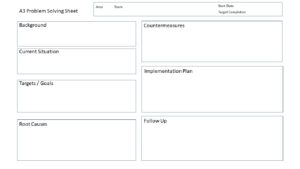
A3 Problem solving is technique based around the PDCA cycle where you use a formal template based on a piece of A3 paper to identify and drive improvements or problem solving. This keeps all of the information local and helps to direct and maintain your efforts.
- Become a Partner
- Find a Partner
- Customer Success Center
- Submit a Ticket
- Planview® AdaptiveWork
- Planview® Advisor Contact your admin for instructions
- Planview® AgilePlace
- Planview® Barometer Contact your admin for instructions
- Planview® ChangePoint Contact your admin for instructions
- Planview® Enterprise Architecture Contact your admin for instructions
- Planview® IdeaPlace Contact your admin for instructions
- Planview® Portfolios Contact your admin for instructions
- Planview® PPM Pro (formerly Innotas ® )
- Planview® ProjectPlace
- Planview® Hub Contact your admin for instructions
- Planview® Viz Contact your admin for instructions
- Back Solutions
- Strategic Portfolio Management Realize strategic objectives at speed Watch demo • Strategic Portfolio Management
- Project Portfolio Management Level-up your projects and portfolios Watch demo • Project Portfolio Management
- Product Portfolio Management Optimize your product pipeline Watch demo • Product Portfolio Management
- Professional Services Automation Modernize your business and service delivery Watch demo • Professional Services Automation
- Value Stream Management Transform into a high-performing tech company Watch demo • Value Stream Management
- Enterprise Agile Planning Drive Agile transformation your way Watch demo • Enterprise Agile Planning
- Software Toolchain Integration Streamline the flow of data Watch demo • Software Toolchain Integration
- Release Management Make releases fast, predictable, smooth, and efficient Watch demo • Release Management
- Test Environment Management Increase efficiency, improve quality, and reduce costs Watch demo • Test Environment Management
- Explore solutions by function and leadership role
- Back Resources
- Resource Center Fast access to the information you need, including articles, documents, reports, videos, blog posts, and more
- Analyst Recognition See what key industry analysts have to say about our solutions
- Customer Stories Hear what our customers have to say about our products
- Product Reviews and Testimonials See how our customers rate our products
- Event Center In person and online opportunities to learn how Planview helps you solve your business problems
- The Planview Blog Insight from the subject matter experts on PMO, product innovation, enterprise architecture, and more
Thought Leadership
- Artificial Intelligence
- Strategy Implementation
- Value Stream Management
- Demos & Free Trials
- Back About Us
- About Us We’re building the digital future of connected work
- Leadership Learn more about the senior leadership team at Planview
- Press Releases Browse recent and past press releases from Planview
- In the News Browse the latest news stories and articles regarding Planview
- Careers View open jobs, and learn more about working at Planview
- 1Open search panel
- Browse Demos
- Popular search: Project Portfolio Management
- Popular search: Enterprise Agile Planning
- Popular search: Strategic Planning
- Popular search: Lean Portfolio Management
- Popular search: Collaborative Work Management
- Popular search: Scaling Agile
- Popular search: Agile Program Management
- Popular search: Enterprise Architecture
- Popular search: Application Portfolio Management
- Popular search: Product Lifecycle Management
- Popular search: New Product Development
Useful Lean Manufacturing Tools
Table of contents.
- 1 Lean Manufacturing Principles
- 2 Lean Manufacturing in Practice
- 3 Useful Lean Manufacturing Tools
- 4 What is Andon in Lean Manufacturing?
- 5 What is 5S?
- 6 What is Just-in-Time Manufacturing?
- 7 How to Implement Lean Manufacturing
- 8 Top Lean Manufacturing Books
What if you could reduce waste, increase efficiency and deliver more value to customers? The answer lies in Lean manufacturing. It sounds like an uphill battle, but with the right Lean manufacturing tools, driving out waste is easier than you might think.
5 Lean Manufacturing Principles
Agileplace free trial: agileplace online kanban software.
Sign up for a 30-day free trial and you and your team can start building online Kanban boards today. Experience for yourself how AgilePlace supports continuous delivery initiatives, eliminates waste and improves your team’s delivery processes and speed.

Here are useful Lean manufacturing tools you need to get started.
Lean Manufacturing Tools to Jumpstart Your Efforts
Whether you’re building a physical product or creating a Lean culture, it helps to have the right tools for the job. Think of this article as a toolbox, from which you can pick and choose the right tools to use in your organization.
Some of them are techniques for managing people and some are frameworks for solving problems, while others offer ways of thinking about or structuring work. All these Lean tools are intended to help you drive out waste, increase efficiency, and make the most of your resources.
PDCA problem solving cycle
The first Lean tool we will discuss is the PDCA cycle, a Lean management tool used to operationalize continuous improvement.
PDCA stands for Plan-Do-Check-Act (sometimes Plan-Do-Check-Adjust) and provides a holistic framework for identifying and solving problems quickly. Included in the PDCA cycle are the following steps:
- Plan for a specific goal
- Do the work required by that plan
- Check the results of the work
- Act / Adjust to fix any unsatisfactory results
When using PDCA as one of the Lean manufacturing tools in their arsenal, some people include an “O” step (for Observe) at the beginning of the cycle, to emphasize the need to understand the current realities of a situation before jumping into “solutionizing.”
PDCA is intended to be a cyclical process–a four-step loop (or five, if you include the O step) that is repeated continuously. It can be particularly helpful when:
- Starting a new improvement project
- Developing a new process, product, or service
- Defining a repetitive work process
- Implementing any change
- Implementing continuous improvement
The Five Whys
Root cause analysis is an important concept in Lean manufacturing, because it helps teams continuously refine their processes to eliminate sources of waste. Without a framework for structuring these analyses, however, teams often don’t dig deeply enough to truly uncover root causes–instead, stopping at more surface-level issues and working to resolve them.
The Five Whys is a simple but effective thinking tool that helps make sure that they are accurately identifying true root causes.
Quite simply, it requires participants to continually ask “why?” questions (typically five or fewer times) to peel back the layers. This questioning allows teams to diagnose problems without any statistical analysis and often identifies multiple root causes and the relationships between them.
Whether or not the Five Whys is used along with other Lean manufacturing tools, it’s a highly versatile thinking tool that can be used on its own in a variety of situations. For examples and use cases of the Five Whys, we recommend this article .
Gemba is a Japanese word that translates to “the real place.” In Lean, it refers to the place (physical or digital) where work is being done–like the shop floor in a manufacturing facility. Going to the Gemba is a way of getting to the heart of where value is created–a call to leaders to get out of their offices and spend time on the plant floor to gain a thorough and accurate understanding of the realities of their working environments.
All too often, decisions about manufacturing value streams are made without consulting the people on the front lines, those who might have the most insight about how to improve processes and resolve issues.
When problems arise, it’s important to go to the Gemba to observe what is happening and make thoughtful decisions that accurately reflect the reality of the problem. The Gemba is one of three important Lean manufacturing tools that can help leaders approach their role with greater humility as they sharpen their analytical skills.
Jidoka (Autonomation)
Jidoka is another Lean manufacturing tool of Japanese origin. It translates to “intelligent automation” or “automation with a human touch” and is a way of maintaining quality control in a semi-automated environment.
Jidoka, or autonomation, involves designing equipment to partially automate the manufacturing process, so that machines can automatically detect defects when they occur, and stop the line so that a human can address them.
The purpose of this Lean tool is to prevent the production of defective products and eliminate overproduction. It also reduces labor costs by eliminating the need for direct human supervision over every station on a production line. With a partially automated system, workers can monitor multiple stations, and focus their attention on resolving problems instead of simply monitoring for quality.
Most Lean manufacturing tools emphasize the importance of visualizing important information and empowering the entire value stream to act upon that information. Andon, or the “Andon cord” is a Lean tool that does both.

t’s a visual feedback system that indicates production status and empowers operators to stop the production process when issues arise – this is called “pulling the Andon cord,” in reference to early systems which used a physical cord to allow operators to stop the production line. (Think of a line in a public bus that you can pull to request the bus to make an unplanned stop.)
Modern Andon systems vary in design, but often involve the use of colored lights, audio signals, text, or other displays to indicate status.
The use of Andon systems is a key part of Just-in-Time manufacturing. By empowering anyone on the line to quickly identify and address issues without waiting for management, manufacturing lines can be more self-sufficient and resolve issues in real-time.
This also encourages everyone on the line to participate in Kaizen (continuous improvement) – because people are more empowered to innovate when they can call out and effect change.
Continuous Flow (aka one-piece flow)
Continuous flow is a Lean manufacturing tool that involves using smaller batch sizes to increase the speed and efficiency of production. Continuous flow refers to the state of continuously, consistently delivering outputs by moving each item through each step of the process, instead of processing items in batches.
Think of it as making pizza: Making one pizza from start to finish – rolling the dough, assembling the toppings, and baking the pizza – and serving the pizza when it’s ready is continuous flow. Rolling out the dough for, let’s say nine pizzas, then assembling the toppings on all nine pizzas, and then baking all nine pizzas – all before being able to serve just one pizza – is delivering in a batch.
Conceptually, it might sound as though delivering outputs one item at a time might be slower than delivering in batches. Practicing continuous flow allows manufacturers to deliver value to their customers more frequently and with fewer delays.
Producing in smaller batches also allows teams to regularly examine the output to make any necessary improvements for the next batch, thereby eliminating waste.
Cellular manufacturing
Cellular manufacturing supports continuous flow by calling on teams to arrange workstations based on the parts they produce in order to minimize travel time for those parts and allow for rapid feedback across stations about any issues.
Together, these two Lean manufacturing tools also enable teams to produce smaller, more efficient batches. Organizations typically achieve cellular manufacturing by arranging workstations in a “U” formation.
Five S (5S)
5S is another of the Lean manufacturing tools focused on workstations. It’s a step-by-step method for organizing, cleaning, and maintaining orderly working environments to maximize efficiency, improve safety, and reduce waste.
In their original Japanese, the five steps of the 5S system each begin with the letter S, which is where the system gets its name: Seiri, Seiton, Seiso, Seiketsu, Shitsuke. These terms have been translated into English, conveniently also all beginning with the letter S:
- Sort (remove any unnecessary materials)
- Set in order (arrange materials so they are easy to find and access)
- Shine (clean the workspace regularly)
- Standardize (make the previous three Ss a standard routine)
- Sustain (institute regular audits)
For a more in-depth explanation of the 5S Lean system and how to implement it, we recommend this article .
Total Quality Management (TQM)
This Lean tool, and the following one, work together as the key operational activities of a quality management system. Total Quality Management refers to organization-wide efforts to install and maintain an environment where employees continuously improve their ability to produce high-quality products on demand.
The word “total” refers to the fact that departments outside of production (such as sales, marketing, accounting, engineering, and design) are equally responsible for actively managing and improving quality in their operations as well–not just those on the production floor.
Total Productive Maintenance (TPM)
Total Productive Maintenance (TPM) is a Lean manufacturing tool that aims to increase operational efficiency of equipment and safety for workers. While TQM focuses on continuously improving the quality of products being produced, TPM focuses on increasing the volume of production by maintaining the reliability of equipment.
Increasing production volume isn’t simply a matter of working faster—because when speed increases, equipment deteriorates faster, creating a greater risk of error and potentially creating more waste.
Increasing production volume is achieved by increasing Overall Equipment Effectiveness, or OEE, which we’ll explain in the next section.
TPM blurs the roles of production and maintenance by empowering operators to help maintain their equipment. The goals of TPM are to achieve a state of perfect production, which means:
- No breakdowns
- No small stops or slow running
- No accidents
The 5S system is the foundation of TPM. The 5S system is a useful Lean manufacturing tool that creates a work environment that is clean and well-maintained. There are eight supporting activities of TPM that build upon this foundation:
- Autonomous Maintenance: Places the responsibility for regular maintenance of equipment into the hands of operators.
- Planned Maintenance: Uses predicted and / or measured failure rates to schedule maintenance tasks.
- Quality Maintenance: Design error detection and prevention into standard production processes.
- Focused Improvement: Form cross-functional teams to proactively identify and act upon opportunities for continuous improvement.
- Early Equipment Management: Use practical knowledge and understanding of equipment gained through TPM to design new equipment.
- Training and Education: Work to proactively identify and fill in knowledge gaps necessary to achieve TPM goals; includes operators, maintenance team members, and managers.
- Safety, Health, and Environment: Target the goal of an accident-free workplace, eliminating potential health and safety risks.
- TPM in Administration: Apply TPM techniques to administrative activities to address waste in administration.
Overall Equipment Effectiveness
Part of TPM is the Overall Equipment Effectiveness (OEE) metric, which measures the percentage of working time that is productive.
OEE is based on scores for availability, performance speed and output quality. Multiplying these three numbers gives the OEE metric, with an 85% best-in-class for organizations using Lean manufacturing tools, a 60% average for organizations using Lean manufacturing tools, and a 40% average for organizations not embracing any Lean manufacturing tools.
Takt time is one of the Lean manufacturing tools focused on measuring customer value . It measures the average rate at which teams must manufacture products to meet demand.

To calculate takt time, divide the working time available for production (in hours, days, weeks) by the units required to meet customer demand. Using this Lean manufacturing tool, if a team works 40 hours a week and the company expects customers to buy 80 units a week, the takt time is 0.5 (40 / 80). This means the team must produce one unit in half an hour to meet customer demand.
Standardized work
Standardized work and takt time are two Lean manufacturing tools that work together. Specifically, standardized work helps teams achieve their takt time by creating and documenting a set, repeatable process for how teams should function. For example, it documents the steps teams should take, the materials they need, and the time required for each step.
Mistake proofing
Mistake proofing focuses on detecting mistakes as they occur (either automatically through technology or manually through inspection) and notifying workers accordingly. Like all Lean manufacturing tools, it helps eliminate waste and increase efficiency, this time by surfacing errors as they occur to prevent defective parts from moving further down the process.
Leveling the workload
Leveling the workload calls for teams to manufacture products consistently despite inconsistencies in customer demand. That means even though customers might buy 100 units one week and 60 units the next week, teams should maintain a consistent output over a set period of time (e.g. a week or a month). This consistency helps teams remain efficient since they do not need to switch setups to manufacture different products in unpredictable patterns.
Embracing Lean Manufacturing Tools
Embracing Lean manufacturing tools like those outlined above can go a long way toward helping your team increase efficiency and reduce costs. Most importantly, these Lean manufacturing tools can help you deliver a higher quality product to customers in a faster and more predictable way – a win for both your operations and your customers.

Senior Marketing Manager
Rachaelle Lynn, a Certified SAFe Agilist, is a marketing manager and subject matter expert at Planview, a market-leading provider of project portfolio management, lean and agile delivery, project management, and innovation management software. Her experience in diverse B2B and B2C industries continue to drive her interest in the SaaS customer journey. Rachaelle holds a BA in Communication Studies from the University of Florida.

IMAGES
COMMENTS
Learn the four types of problems and explore the process of lean problem solving to overcome obstacles and improve work processes.
Oct 19, 2017 · Root Cause Analysis is a lean problem-solving method that aims to get to the root of a problem. The philosophy of RCA is predicated on the idea that it’s best to treat the root cause of a problem, not the obvious symptoms. By treating the root cause, manufacturers can eliminate larger problems down the road.
Mar 15, 2024 · By carefully evaluating the problem, data requirements, and team proficiency, you can confidently choose the right Lean Six Sigma tools to drive impactful and sustainable change within your organization.
Need to improve production? Learn the 25 most important types of lean tools and techniques to start using today.
Nov 10, 2022 · In this blog, you’ll be learning about four lean tools for simple problem solving: 5G, 5W1H, 4M1D, and 5 Whys. In essence, these four tools create a structured approach to solving less complex problems. An important aspect of the Lean methodology is being able to solve business setting problems.
Oct 1, 2024 · Use lean problem-solving tools like the Fishbone Diagram in the Define stage of Design Thinking; Apply lean principles to streamline the prototyping process in Design Thinking; Incorporate lean metrics into the testing phase of Design Thinking
There are many Lean Manufacturing Tools and other ideas and principles that are associated with Lean. Most of these tools should be implemented within the main principles of Lean and as part of a clearly defined and planned roll out to improve your business.
Nov 7, 2021 · In this blog post, I’ll touch on these five tools, from the House of Lean: Ishikawa Diagramming; Causal Loop Diagramming; A3 Problem Solving; Hoshin Kanri; Value Stream Mapping
The A3 Problem Solving process’s five steps – Define the Problem, Gather Data, Identify Root Causes, Develop Solutions, and Implement Solutions – provide a road map for effectively addressing problems and making long-term improvements.
Here are useful Lean manufacturing tools you need to get started. Whether you’re building a physical product or creating a Lean culture, it helps to have the right tools for the job. Think of this article as a toolbox, from which you can pick and choose the right tools to use in your organization.